Paul van Yperen's Blog, page 259
September 17, 2018
Anton Walbrook
Dark and handsome Anton Walbrook or Adolf Wohlbrück (1896-1967) was a distinguished Austrian actor who starred in early German sound films as Walzerkrieg (1933) and Viktor und Viktoria (1933). After the rise of Adolph Hitler, he settled in Great Britain where he appeared in such film classics as The Life and Death of Colonel Blimp (1943) and The Red Shoes (1948). He also played the ringmaster in La Ronde (1950).
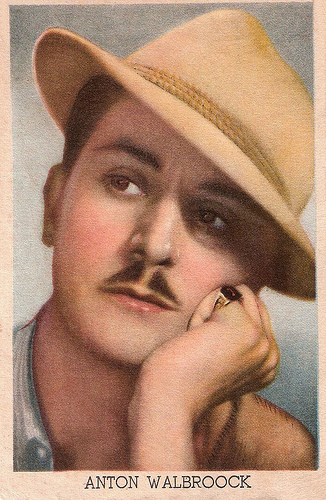
Vintage collectors card.
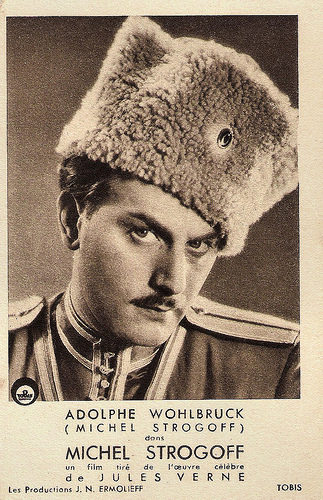
French postcard by Les Productions J.N. Ermolieff / Tobis. Photo publicity still for Michel Strogoff (Jacques de Baroncelli, Richard Eichberg, 1936), based on the novel by Jules Verne.
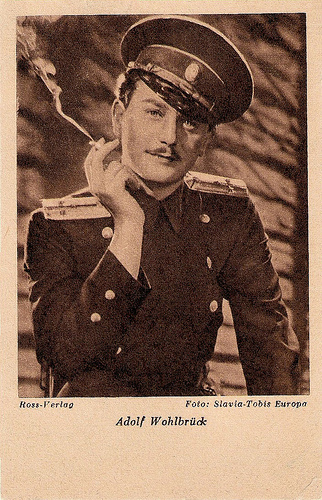
German postcard by Ross Verlag/Das Programm von Heute. Photo: Slavia - Tobis Europa. Publicity still for Port Arthur (Nicolas Farkas, 1936).
Gender-bending
Anton Walbrook was born as Adolf Anton Wilhelm Wohlbrück in Vienna, Austria-Hungary (now Austria) in 1896. He was the son of Adolf Wohlbrück II and his Austrian wife Gisela Rosa Cohn. He descended from ten generations of actors though his father broke with tradition and had become a circus clown.
Young Adolf studied with the famous stage director Max Reinhardt, who signed him to a five-year contract at the Deutsches Theater. In 1915 he had made his film debut as a circus director in the German silent film Marionetten/Marionettes (Richard Löwenbein, 1915).
During the mid-1920s, he starred in several films of the Stuart Webbs detective series, but the young actor was not noted in them. After the advent of sound film, this changed. He had a leading part opposite Anna Sten in the German language version of the drama Salto Mortale/Trapeze (Ewald André Dupont, 1931) and starred opposite Heinz Rühmann in the comedy Der Stolz der 3. Kompanie/The Pride of the Third Company (Fred Sauer, 1932).
Opposite lovely Anny Ondra , he appeared in the musical comedy Baby (Carl Lamac, 1932). The dashing actor then graced a number of romantic films. He played Johann Strauss in the UFA operetta Walzerkrieg/The Battle of the Waltzes (Ludwig Berger, 1933) opposite Renate Müller .
Again with Müller, he appeared in the gender-bending UFA-comedy Viktor und Viktoria/Viktor and Viktoria (Reinhold Schünzel, 1933), which later served as the inspiration and basis for the Hollywood comedy Victor Victoria (Blake Edwards, 1982) starring Julie Andrews . He also appeared in the French version, Georges et Georgette (Roger Le Bon, Reinhold Schünzel, 1934), with Meg Lemonnier replacing Müller.
A huge hit was Maskerade/Masquerade in Vienna (Willi Forst, 1934) with Paula Wessely . Thensellek reviews at IMDb : “A delightful movie, full of atmosphere of the post World War I Vienna. (...) The story is told quickly, the scenes full of wit and very discreet erotic hints. The leads are cast with two of Austria finest (...). If you want to dive deeply into Austrian culture and understand the country's roots, then watch this wonderful movie.”
Another interesting role was that of the student Balduin in the fantasy film Der Student von Prag/The Student of Prague (Arthur Robison, 1935), a new and different version of the silent classic of 1913 starring Paul Wegener .
In 1936 Wohlbrück went to Hollywood to reshoot dialogue for the RKO production The Soldier and the Lady (George Nicholls, 1937) the English language version of the Jules Verne adaptation Der Kurier des Zaren/The Czar's Courier (Richard Eichberg, 1936) in which he played Michael Strogoff, a role he had also played impeccably in the French and German versions. In Hollywood he changed his name from Adolf Wohlbrück into Anton Walbrook.
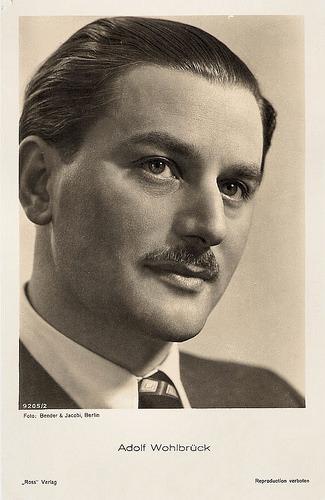
German postcard by Ross Verlag. no. 9205/2, 1935-1936. Photo: Bender & Jacobi, Berlin.
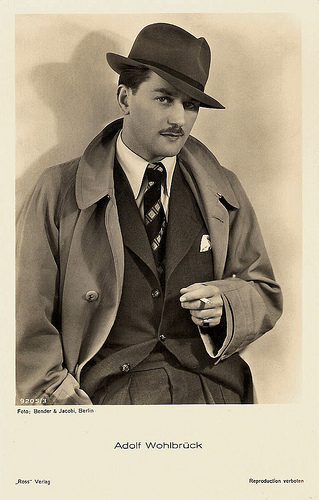
German postcard by Ross Verlag, no. 9205/3, 1935-1936. Photo: Bender & Jacobi, Berlin.
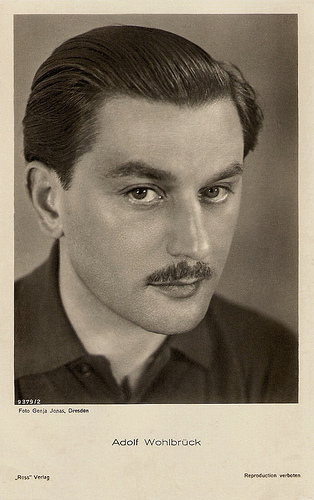
German postcard by Ross Verlag, no. 9379/2, 1935-1936. Photo: Genja Jonas, Dresden.
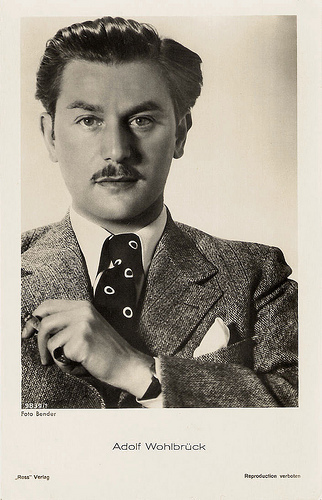
German postcard by Ross Verlag, no. 9839/1, 1935-1936. Photo: Bender.
Half-Jewish and Homosexual
Anton Walbrook was classified under the Nuremberg Laws as half-Jewish. He was also a homosexual and a political opponent of the Nazi regime. So instead of returning to Austria, he decided to settle in England.
There he continued working as a film actor making a speciality of playing continental Europeans with his trademark moustache. Meanwhile he supported Jewish actors and their families in Germany from London.
Producer-director Herbert Wilcox cast him as Prince Albert opposite Anna Neagle as Queen Victoria in the black-and-white costume film Victoria the Great (Herbert Wilcox, 1937) and Walbrook also appeared in the colour sequel, Sixty Glorious Years (Herbert Wilcox, 1938). He was also on the London stage from 1939 in Design for Living.
In the original film version of the stage thriller Gaslight (Thorold Dickenson, 1940), he was the sadistic husband of Diana Wynyard , roles played by Charles Boyer and Ingrid Bergman in the later Hollywood remake. In the romantic melodrama Dangerous Moonlight (Brian Desmond Hurst, 1941), Walbrook was a Polish pianist torn over whether to return home.
Walbrook played a gentle pacifist in the wartime propaganda film 49th Parallel (Michael Powell, 1941), made by the team of director Michael Powell and writer-producer Emeric Pressburger. In their satire The Life and Death of Colonel Blimp (Michael Powell, 1943) he played the role of the dashing, intense ‘good German’ officer Theo Kretschmar-Schuldorff.
In their greatest hit, the romantic melodrama The Red Shoes (Michael Powell, 1948), he was the tyrannical but charismatic impresario Lermontov who poises ballerina Victoria Page ( Moira Shearer ) to superstardom. Lotti St writes at IMDb : “Anton Walbrook is the star of this film, playing a Diaghilev type character and absolutely dominates any scene he is in. He is not bombastic in a showy, hammy way. It is a more silent but deadly charismatic performance. It is a pity he did not receive an award for it. He is stern, uncompromising, cold and passionate and absolutely deadly. He is a gentleman tough guy.”
One of his most unusual films is the brilliant The Queen of Spades (Thorold Dickenson, 1949), an odd, Gothic thriller based on the Alexander Pushkin short story in which Walbrook co-starred with Edith Evans. In 1947, Walbrook had become a British citizen.
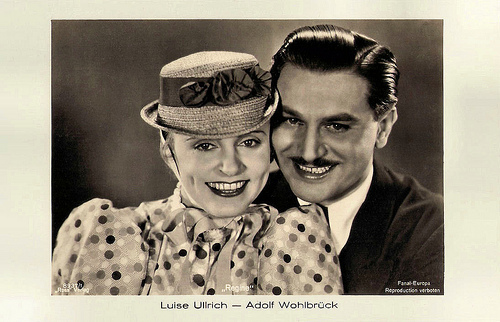
German postcard by Ross Verlag, no. 8937/1, 1933-1934. Photo: Fanal-Europa. Publicity still for Regine (Erich Waschneck, 1935) with Luise Ullrich .
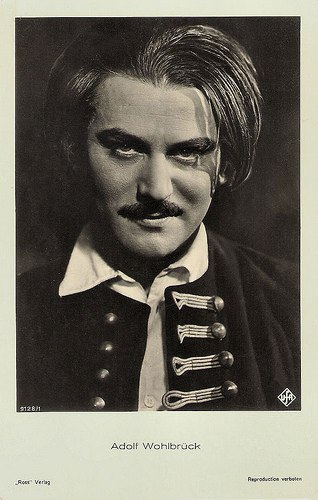
German postcard by Ross Verlag. no. 9128/1, 1935-1936. Photo: Ufa. Publicity still for Zigeunerbaron/The Gypsy Baron (Karl Hartl, 1935).
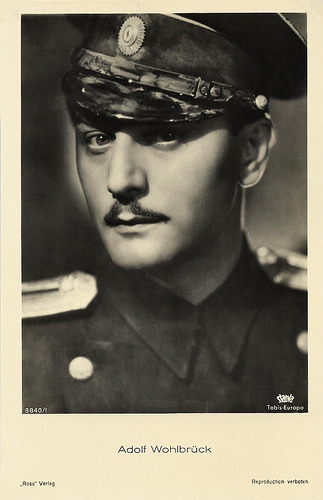
German postcard by Ross Verlag. no. 9840/1, 1935-1936. Photo: Tobis-Europa / Stania. Publicity still for Port Arthur (Nicolas Farkas, 1936).
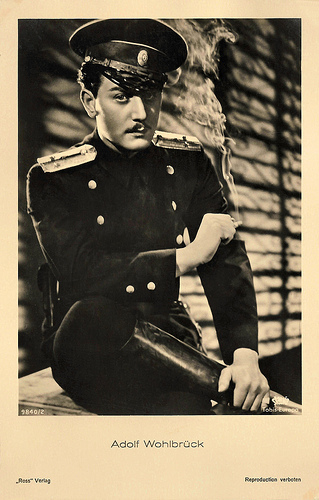
German postcard by Ross Verlag, no. 9840/2, 1935-1936. Photo: Tobis-Europa / Stania. Publicity still for Port Arthur (Nicolas Farkas, 1936).
Chilling Arrogance and Tragic Pathos
During the 1950s, Anton Walbrook appeared in British productions as well as in continental films. In the French classic La Ronde/The round of love (Max Ophüls, 1950), he was the gently ironic ringmaster who guides us through a series of affairs in Vienna, around 1900. Another French production was L'affaire Maurizius/On Trial (Julien Duvivier, 1954) starring Daniel Gélin .
In Great Britain, he reunited with Powell and Pressburger for their musical Oh... Rosalinda!! (Michael Powell, Emeric Pressburger, 1955) featuring Ludmilla Tchérina . It was an updated version of Johann Strauss's 1874 operetta Die Fledermaus (The Bat) and Walbrook played the role of Dr. Falke a.k.a. the Bat.
For Ophüls, he then played king Ludwig I of Bavaria in Lola Montès (Max Ophüls, 1955) starring Martine Carol . He also appeared in Saint Joan (Otto Preminger, 1957) with Jean Seberg as Joan of Arc. His last English-speaking film was I Accuse! (José Ferrer, 1958), in which he played again a stiff and stern military officer.
He then retired from films but continued to perform on stage. He also appeared in some German television films, including a new version of the classic Hollywood mystery Laura (Franz Josef Wild, 1962) with Hildegard Knef , and Robert und Elisabeth (Eberhard Schröder, 1966) with Sabine Sinjen .
In March 1967, Anton Walbrook collapsed during a performance of Noel Coward’s play A Song at Twilight at Munich’s Kleine Komödie. He was just honoured with the notable award the Filmband in Gold for his longtime and important contributions to the German cinema.
Later that year he died of the consequences of a heart attack in Garatshausen, Germany. His ashes were interred in the churchyard of St. John's Church in London, as he had wished in his testament. Tim Bergfelder notes in the Encyclopedia of British Cinema that “Anton Walbrook's screen acting combined melancholic irony and old-worldly charm, chilling arrogance and tragic pathos.”
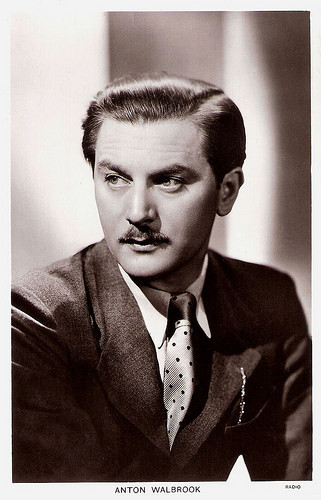
British postcard in the Picturegoer series, London no. 1153. Photo: Radio.

British postcard in the Picturegoer Series, London, no. W. 432. Photo: J. Arthur Rank Organization Ltd.
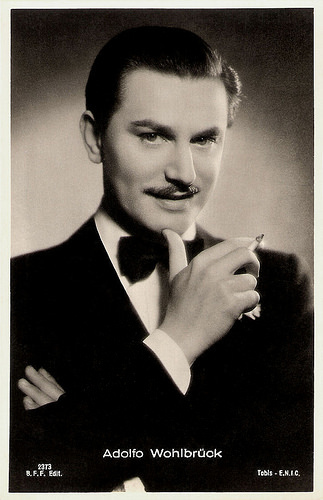
Italian postcard by B.F.F. Edit. no. 2273. Photo: Tobis / E.N.I.C.
Scene from Life of Colonel Blimp (1943). Source: Mutikonka (YouTube).
Sources: Tim Bergfelder (Encyclopedia of British Cinema), (IMDb), Filmportal.de, Wikipedia (English and German), and .

Vintage collectors card.

French postcard by Les Productions J.N. Ermolieff / Tobis. Photo publicity still for Michel Strogoff (Jacques de Baroncelli, Richard Eichberg, 1936), based on the novel by Jules Verne.

German postcard by Ross Verlag/Das Programm von Heute. Photo: Slavia - Tobis Europa. Publicity still for Port Arthur (Nicolas Farkas, 1936).
Gender-bending
Anton Walbrook was born as Adolf Anton Wilhelm Wohlbrück in Vienna, Austria-Hungary (now Austria) in 1896. He was the son of Adolf Wohlbrück II and his Austrian wife Gisela Rosa Cohn. He descended from ten generations of actors though his father broke with tradition and had become a circus clown.
Young Adolf studied with the famous stage director Max Reinhardt, who signed him to a five-year contract at the Deutsches Theater. In 1915 he had made his film debut as a circus director in the German silent film Marionetten/Marionettes (Richard Löwenbein, 1915).
During the mid-1920s, he starred in several films of the Stuart Webbs detective series, but the young actor was not noted in them. After the advent of sound film, this changed. He had a leading part opposite Anna Sten in the German language version of the drama Salto Mortale/Trapeze (Ewald André Dupont, 1931) and starred opposite Heinz Rühmann in the comedy Der Stolz der 3. Kompanie/The Pride of the Third Company (Fred Sauer, 1932).
Opposite lovely Anny Ondra , he appeared in the musical comedy Baby (Carl Lamac, 1932). The dashing actor then graced a number of romantic films. He played Johann Strauss in the UFA operetta Walzerkrieg/The Battle of the Waltzes (Ludwig Berger, 1933) opposite Renate Müller .
Again with Müller, he appeared in the gender-bending UFA-comedy Viktor und Viktoria/Viktor and Viktoria (Reinhold Schünzel, 1933), which later served as the inspiration and basis for the Hollywood comedy Victor Victoria (Blake Edwards, 1982) starring Julie Andrews . He also appeared in the French version, Georges et Georgette (Roger Le Bon, Reinhold Schünzel, 1934), with Meg Lemonnier replacing Müller.
A huge hit was Maskerade/Masquerade in Vienna (Willi Forst, 1934) with Paula Wessely . Thensellek reviews at IMDb : “A delightful movie, full of atmosphere of the post World War I Vienna. (...) The story is told quickly, the scenes full of wit and very discreet erotic hints. The leads are cast with two of Austria finest (...). If you want to dive deeply into Austrian culture and understand the country's roots, then watch this wonderful movie.”
Another interesting role was that of the student Balduin in the fantasy film Der Student von Prag/The Student of Prague (Arthur Robison, 1935), a new and different version of the silent classic of 1913 starring Paul Wegener .
In 1936 Wohlbrück went to Hollywood to reshoot dialogue for the RKO production The Soldier and the Lady (George Nicholls, 1937) the English language version of the Jules Verne adaptation Der Kurier des Zaren/The Czar's Courier (Richard Eichberg, 1936) in which he played Michael Strogoff, a role he had also played impeccably in the French and German versions. In Hollywood he changed his name from Adolf Wohlbrück into Anton Walbrook.

German postcard by Ross Verlag. no. 9205/2, 1935-1936. Photo: Bender & Jacobi, Berlin.

German postcard by Ross Verlag, no. 9205/3, 1935-1936. Photo: Bender & Jacobi, Berlin.

German postcard by Ross Verlag, no. 9379/2, 1935-1936. Photo: Genja Jonas, Dresden.

German postcard by Ross Verlag, no. 9839/1, 1935-1936. Photo: Bender.
Half-Jewish and Homosexual
Anton Walbrook was classified under the Nuremberg Laws as half-Jewish. He was also a homosexual and a political opponent of the Nazi regime. So instead of returning to Austria, he decided to settle in England.
There he continued working as a film actor making a speciality of playing continental Europeans with his trademark moustache. Meanwhile he supported Jewish actors and their families in Germany from London.
Producer-director Herbert Wilcox cast him as Prince Albert opposite Anna Neagle as Queen Victoria in the black-and-white costume film Victoria the Great (Herbert Wilcox, 1937) and Walbrook also appeared in the colour sequel, Sixty Glorious Years (Herbert Wilcox, 1938). He was also on the London stage from 1939 in Design for Living.
In the original film version of the stage thriller Gaslight (Thorold Dickenson, 1940), he was the sadistic husband of Diana Wynyard , roles played by Charles Boyer and Ingrid Bergman in the later Hollywood remake. In the romantic melodrama Dangerous Moonlight (Brian Desmond Hurst, 1941), Walbrook was a Polish pianist torn over whether to return home.
Walbrook played a gentle pacifist in the wartime propaganda film 49th Parallel (Michael Powell, 1941), made by the team of director Michael Powell and writer-producer Emeric Pressburger. In their satire The Life and Death of Colonel Blimp (Michael Powell, 1943) he played the role of the dashing, intense ‘good German’ officer Theo Kretschmar-Schuldorff.
In their greatest hit, the romantic melodrama The Red Shoes (Michael Powell, 1948), he was the tyrannical but charismatic impresario Lermontov who poises ballerina Victoria Page ( Moira Shearer ) to superstardom. Lotti St writes at IMDb : “Anton Walbrook is the star of this film, playing a Diaghilev type character and absolutely dominates any scene he is in. He is not bombastic in a showy, hammy way. It is a more silent but deadly charismatic performance. It is a pity he did not receive an award for it. He is stern, uncompromising, cold and passionate and absolutely deadly. He is a gentleman tough guy.”
One of his most unusual films is the brilliant The Queen of Spades (Thorold Dickenson, 1949), an odd, Gothic thriller based on the Alexander Pushkin short story in which Walbrook co-starred with Edith Evans. In 1947, Walbrook had become a British citizen.

German postcard by Ross Verlag, no. 8937/1, 1933-1934. Photo: Fanal-Europa. Publicity still for Regine (Erich Waschneck, 1935) with Luise Ullrich .

German postcard by Ross Verlag. no. 9128/1, 1935-1936. Photo: Ufa. Publicity still for Zigeunerbaron/The Gypsy Baron (Karl Hartl, 1935).

German postcard by Ross Verlag. no. 9840/1, 1935-1936. Photo: Tobis-Europa / Stania. Publicity still for Port Arthur (Nicolas Farkas, 1936).

German postcard by Ross Verlag, no. 9840/2, 1935-1936. Photo: Tobis-Europa / Stania. Publicity still for Port Arthur (Nicolas Farkas, 1936).
Chilling Arrogance and Tragic Pathos
During the 1950s, Anton Walbrook appeared in British productions as well as in continental films. In the French classic La Ronde/The round of love (Max Ophüls, 1950), he was the gently ironic ringmaster who guides us through a series of affairs in Vienna, around 1900. Another French production was L'affaire Maurizius/On Trial (Julien Duvivier, 1954) starring Daniel Gélin .
In Great Britain, he reunited with Powell and Pressburger for their musical Oh... Rosalinda!! (Michael Powell, Emeric Pressburger, 1955) featuring Ludmilla Tchérina . It was an updated version of Johann Strauss's 1874 operetta Die Fledermaus (The Bat) and Walbrook played the role of Dr. Falke a.k.a. the Bat.
For Ophüls, he then played king Ludwig I of Bavaria in Lola Montès (Max Ophüls, 1955) starring Martine Carol . He also appeared in Saint Joan (Otto Preminger, 1957) with Jean Seberg as Joan of Arc. His last English-speaking film was I Accuse! (José Ferrer, 1958), in which he played again a stiff and stern military officer.
He then retired from films but continued to perform on stage. He also appeared in some German television films, including a new version of the classic Hollywood mystery Laura (Franz Josef Wild, 1962) with Hildegard Knef , and Robert und Elisabeth (Eberhard Schröder, 1966) with Sabine Sinjen .
In March 1967, Anton Walbrook collapsed during a performance of Noel Coward’s play A Song at Twilight at Munich’s Kleine Komödie. He was just honoured with the notable award the Filmband in Gold for his longtime and important contributions to the German cinema.
Later that year he died of the consequences of a heart attack in Garatshausen, Germany. His ashes were interred in the churchyard of St. John's Church in London, as he had wished in his testament. Tim Bergfelder notes in the Encyclopedia of British Cinema that “Anton Walbrook's screen acting combined melancholic irony and old-worldly charm, chilling arrogance and tragic pathos.”

British postcard in the Picturegoer series, London no. 1153. Photo: Radio.

British postcard in the Picturegoer Series, London, no. W. 432. Photo: J. Arthur Rank Organization Ltd.

Italian postcard by B.F.F. Edit. no. 2273. Photo: Tobis / E.N.I.C.
Scene from Life of Colonel Blimp (1943). Source: Mutikonka (YouTube).
Sources: Tim Bergfelder (Encyclopedia of British Cinema), (IMDb), Filmportal.de, Wikipedia (English and German), and .
Published on September 17, 2018 22:00
September 16, 2018
Elisabeth Müller
Swiss actress Elisabeth Müller (1926-2006) was a popular star of the German Cinema in the 1950s. Her popularity brought her to Hollywood where she appeared in a few films.
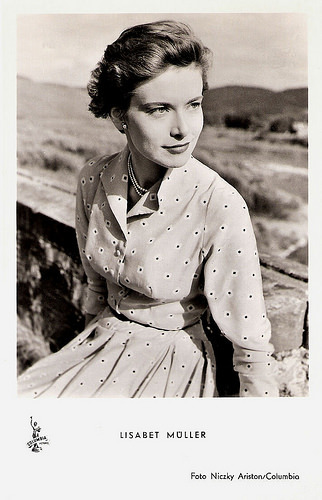
German postcard by Kunst und Bild, Berlin, no. A 1107. Photo: Joe Niczky / Ariston / Columbia. Publicity still for Moselfahrt aus Liebeskümmer/Heartbroken on the Moselle (Kurt Hoffmann, 1953).
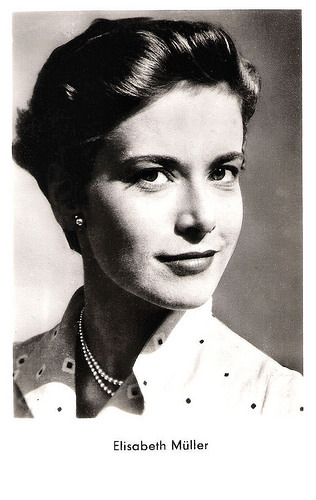
East-German postcard by VEB Progress Film-Vertrieb, Berlin, no. 238. Photo: Ariston-Film. Publicity still for Moselfahrt aus Liebeskümmer/Heartbroken on the Moselle (Kurt Hoffmann, 1953).
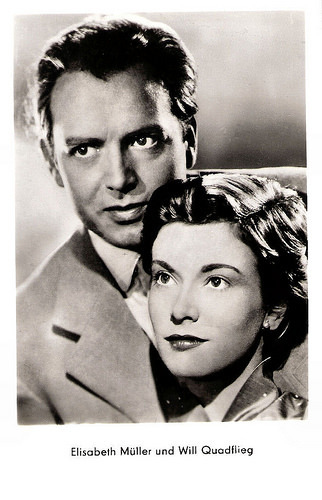
East-German postcard by Progress, Berlin, no. 242, 1956. Photo: Ariston-Film. Publicity still for Moselfahrt aus Liebeskümmer/Heartbroken on the Moselle (Kurt Hoffmann, 1953) with Will Quadflieg .
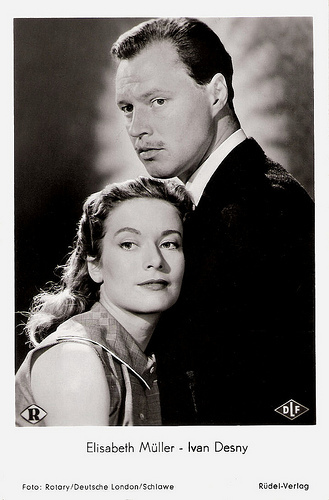
German postcard by Rüdel-Verlag, Hamburg-Bergedorf, no. 1364. Photo: Rotary / Deutsche London / Schlawe. Publicity still for André und Ursula/Andre and Ursula (Werner Jacobs, 1955) with Ivan Desny .
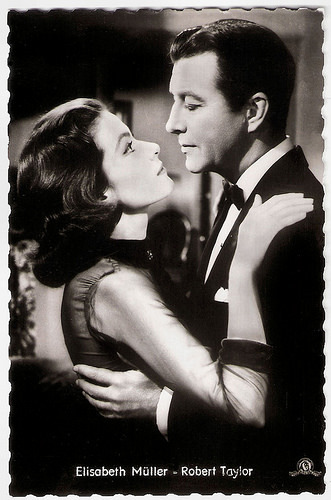
German postcard by Kolibri-Verlag G.m.b.H., Minden/Westf, no. 2819. Photo: Metro-Goldwyn-Mayer. Publicity still for The Power and the Prize (Henry Koster, 1956) with Robert Taylor.
A Darling of the Cinema Public
Elisabeth Müller was born in Basel, Switzerland in 1926.
She studied acting with her aunt, stage actress Ellen Widmann, and between 1944 and 1946 she followed classes at the Schauspielschule Zürich. The next years she worked in many Swiss and German theatre companies.
As Lisabet Müller, she made her film debut in Paragraph 51 – Seelenarzt Dr. Laduner/Paragraph 51 - Headshrinker Dr. Laduner (Leopold Lindtberg, 1947). Another popular Swiss film with her was the crime film Matto regiert/Madness Rules (Leopold Lindtberg, 1947).
In Germany, she played in the comedy Der Tag vor der Hochzeit/The Day before the Wedding (Rolf Thiele, 1952) opposite Paul Dahlke and Joachim Brennecke .
Her first big hit, the sentimental romance Moselfahrt aus Liebeskummer/Heartbroken on the Moselle
(Kurt Hoffmann, 1953) with Will Quadflieg , made her a darling of the cinema public in the 1950s.
Next she worked twice with the legendary director G.W. Pabst, for the crime drama Das Bekenntnis der Ina Kahr/Afraid to Love (Georg Wilhelm Pabst, 1954) with Curd Jürgens , and for the drama Rosen für Bettina/Ballerina (Georg Wilhelm Pabst, 1956) opposite Willy Birgel .
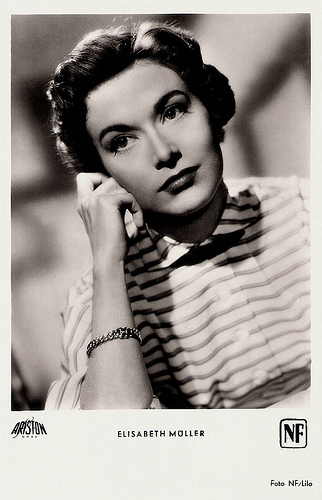
German postcard by Kunst und Bild, Berlin, no. A 1218. Photo: NF / Lilo / Ariston GmbH. Publicity still for Morgengrauen/Dawn (Viktor Tourjansky, 1954).
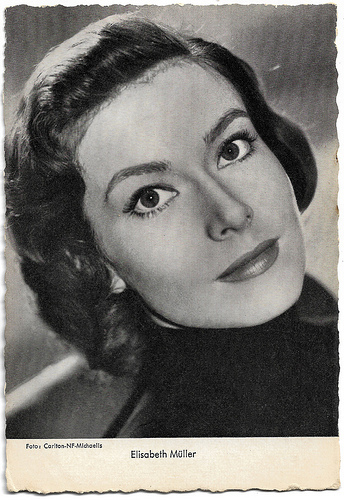
German postcard by WS-Druck, Wanne-Eickel. Photo: Carlton / NF / Michaelis. Publicity still for Rosen für Bettina/Ballerina (G.W. Pabst, 1955).
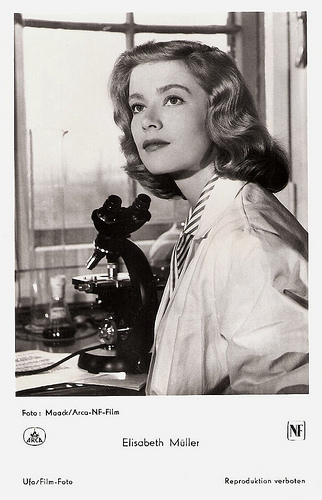
German postcard by Universum-Film Aktiengesellschaft, Berlin-Tempelhof, no. FK 3488. Retail price: 25 Pfg. Photo: Maack / Arca-NF-Film. Publicity still for Geliebte Corinna/Beloved Corinna (Eduard von Borsody, 1956).
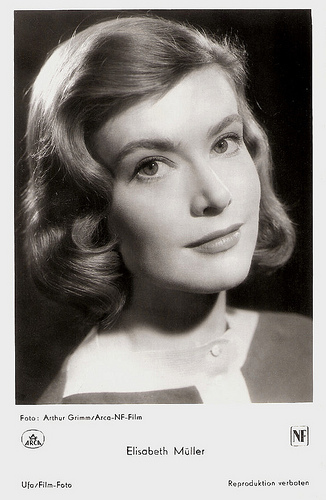
German postcard by Universum-Film Aktiengesellschaft, Berlin-Tempelhof, no. FK 3489. Retail price: 25 Pfg. Photo: Arthur Grimm / Arca-NF-Film. Publicity still for Geliebte Corinna/Beloved Corinna (Eduard von Borsody, 1956).
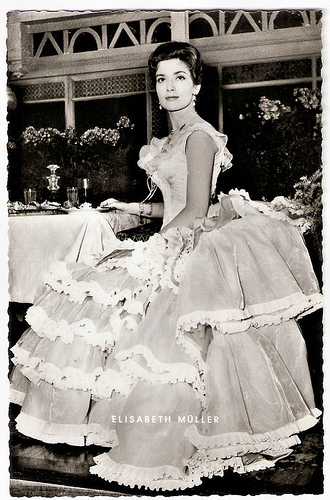
German postcard by Kunst und Bild, Berlin-Charlottenburg, no. T 871. Photo: Vienna / Schorcht / Hämmerer. Publicity still for Skandal in Ischi/Scandal in Bad Ischl (Rolf Thiele, 1957).
Hollywood
Her popularity brought Elisabeth Müller to Hollywood where she appeared in The Power and the Prize (Henry Koster, 1956), costarring with Robert Taylor, and the war drama The Angry Hills (Robert Aldrich, 1957-1959) with Robert Mitchum and based on a novel by Leon Uris. Neither film was a commercial success.
She returned to Europe where she appeared in such films as Taxichauffeur Bänz/Taxi Driver Bänz (Werner Düggelin, Hermann Haller, 1957) with Maximilian Schell in one of his first roles, and El Hakim (Rolf Thiele, 1957) with O.W. Fischer .
Her biggest TV success was the Mini-series Am grünen Strand der Spree/At the Green Beach of the River Spree (Fritz Umgelter, 1960) with Peter Pasetti , based on a novel by Hans Scholz.
Since the early 1960s, she worked mainly in the theatre, but in the 1960s and in the 1980s she also occasionally was seen in TV films like Ottiliens Tollheiten/Ottilien's Follies (Ludwig Berger, 1964) and Die Tote im Schlosspark/The Body in Schlosspark (Jürgen Goslar, 1984).
At the age of 80, Elisabeth Müller passed away in 2006 in Sempach, Switzerland. She was married to director and director of photography Kurt Grigoleit.
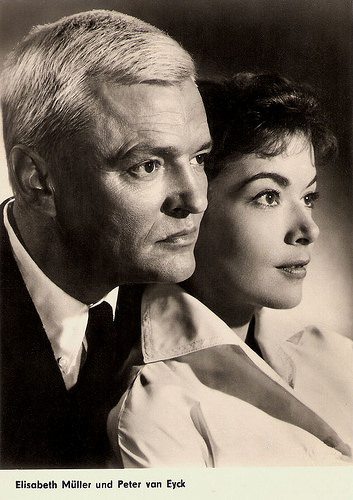
East-German postcard by VEB Progress Film-Vertrieb, Berlin, no. 1534, 1961. Retail price: 0,20 DM. Photo: publicity still for Dr. Crippen lebt/Doctor Crippen lives (Erich Engels, 1958) with Peter van Eyck .
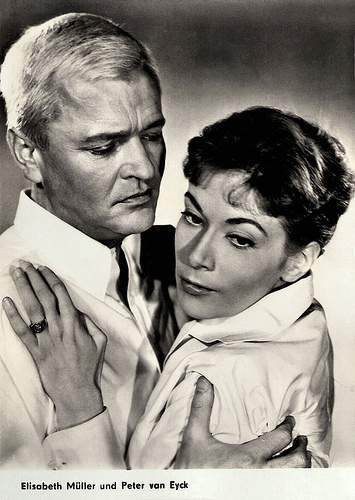
East-German postcard by VEB Progress Film-Vertrieb, Berlin, no. 1535, 1961. Retail price: 0,20 DM. Photo: publicity still for Dr. Crippen lebt/Doctor Crippen lives (Erich Engels, 1958) with Peter van Eyck .
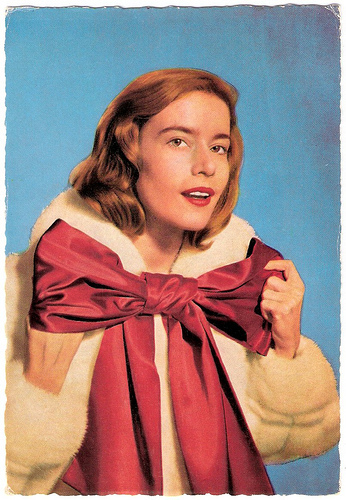
German postcard by WS-Druck, Wanne-Eickel, no. F 41. Photo: Klaus Collignon.
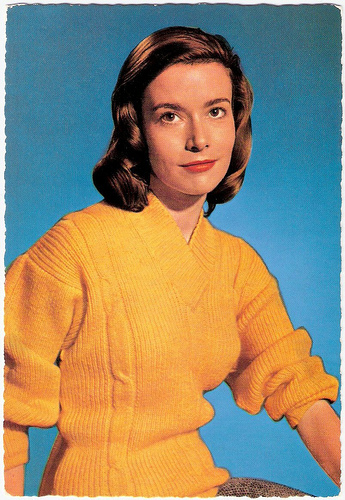
German postcard by WS-Druck, Wanne-Eickel, no. F 114. Photo: Klaus Collignon.
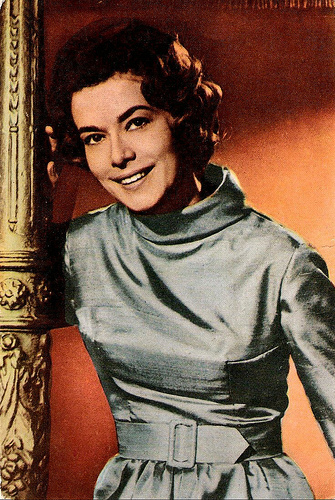
Belgian postcard by Cox, no. 12.
Sources: Wikipedia (German) and .

German postcard by Kunst und Bild, Berlin, no. A 1107. Photo: Joe Niczky / Ariston / Columbia. Publicity still for Moselfahrt aus Liebeskümmer/Heartbroken on the Moselle (Kurt Hoffmann, 1953).

East-German postcard by VEB Progress Film-Vertrieb, Berlin, no. 238. Photo: Ariston-Film. Publicity still for Moselfahrt aus Liebeskümmer/Heartbroken on the Moselle (Kurt Hoffmann, 1953).

East-German postcard by Progress, Berlin, no. 242, 1956. Photo: Ariston-Film. Publicity still for Moselfahrt aus Liebeskümmer/Heartbroken on the Moselle (Kurt Hoffmann, 1953) with Will Quadflieg .

German postcard by Rüdel-Verlag, Hamburg-Bergedorf, no. 1364. Photo: Rotary / Deutsche London / Schlawe. Publicity still for André und Ursula/Andre and Ursula (Werner Jacobs, 1955) with Ivan Desny .

German postcard by Kolibri-Verlag G.m.b.H., Minden/Westf, no. 2819. Photo: Metro-Goldwyn-Mayer. Publicity still for The Power and the Prize (Henry Koster, 1956) with Robert Taylor.
A Darling of the Cinema Public
Elisabeth Müller was born in Basel, Switzerland in 1926.
She studied acting with her aunt, stage actress Ellen Widmann, and between 1944 and 1946 she followed classes at the Schauspielschule Zürich. The next years she worked in many Swiss and German theatre companies.
As Lisabet Müller, she made her film debut in Paragraph 51 – Seelenarzt Dr. Laduner/Paragraph 51 - Headshrinker Dr. Laduner (Leopold Lindtberg, 1947). Another popular Swiss film with her was the crime film Matto regiert/Madness Rules (Leopold Lindtberg, 1947).
In Germany, she played in the comedy Der Tag vor der Hochzeit/The Day before the Wedding (Rolf Thiele, 1952) opposite Paul Dahlke and Joachim Brennecke .
Her first big hit, the sentimental romance Moselfahrt aus Liebeskummer/Heartbroken on the Moselle
(Kurt Hoffmann, 1953) with Will Quadflieg , made her a darling of the cinema public in the 1950s.
Next she worked twice with the legendary director G.W. Pabst, for the crime drama Das Bekenntnis der Ina Kahr/Afraid to Love (Georg Wilhelm Pabst, 1954) with Curd Jürgens , and for the drama Rosen für Bettina/Ballerina (Georg Wilhelm Pabst, 1956) opposite Willy Birgel .

German postcard by Kunst und Bild, Berlin, no. A 1218. Photo: NF / Lilo / Ariston GmbH. Publicity still for Morgengrauen/Dawn (Viktor Tourjansky, 1954).

German postcard by WS-Druck, Wanne-Eickel. Photo: Carlton / NF / Michaelis. Publicity still for Rosen für Bettina/Ballerina (G.W. Pabst, 1955).

German postcard by Universum-Film Aktiengesellschaft, Berlin-Tempelhof, no. FK 3488. Retail price: 25 Pfg. Photo: Maack / Arca-NF-Film. Publicity still for Geliebte Corinna/Beloved Corinna (Eduard von Borsody, 1956).

German postcard by Universum-Film Aktiengesellschaft, Berlin-Tempelhof, no. FK 3489. Retail price: 25 Pfg. Photo: Arthur Grimm / Arca-NF-Film. Publicity still for Geliebte Corinna/Beloved Corinna (Eduard von Borsody, 1956).

German postcard by Kunst und Bild, Berlin-Charlottenburg, no. T 871. Photo: Vienna / Schorcht / Hämmerer. Publicity still for Skandal in Ischi/Scandal in Bad Ischl (Rolf Thiele, 1957).
Hollywood
Her popularity brought Elisabeth Müller to Hollywood where she appeared in The Power and the Prize (Henry Koster, 1956), costarring with Robert Taylor, and the war drama The Angry Hills (Robert Aldrich, 1957-1959) with Robert Mitchum and based on a novel by Leon Uris. Neither film was a commercial success.
She returned to Europe where she appeared in such films as Taxichauffeur Bänz/Taxi Driver Bänz (Werner Düggelin, Hermann Haller, 1957) with Maximilian Schell in one of his first roles, and El Hakim (Rolf Thiele, 1957) with O.W. Fischer .
Her biggest TV success was the Mini-series Am grünen Strand der Spree/At the Green Beach of the River Spree (Fritz Umgelter, 1960) with Peter Pasetti , based on a novel by Hans Scholz.
Since the early 1960s, she worked mainly in the theatre, but in the 1960s and in the 1980s she also occasionally was seen in TV films like Ottiliens Tollheiten/Ottilien's Follies (Ludwig Berger, 1964) and Die Tote im Schlosspark/The Body in Schlosspark (Jürgen Goslar, 1984).
At the age of 80, Elisabeth Müller passed away in 2006 in Sempach, Switzerland. She was married to director and director of photography Kurt Grigoleit.

East-German postcard by VEB Progress Film-Vertrieb, Berlin, no. 1534, 1961. Retail price: 0,20 DM. Photo: publicity still for Dr. Crippen lebt/Doctor Crippen lives (Erich Engels, 1958) with Peter van Eyck .

East-German postcard by VEB Progress Film-Vertrieb, Berlin, no. 1535, 1961. Retail price: 0,20 DM. Photo: publicity still for Dr. Crippen lebt/Doctor Crippen lives (Erich Engels, 1958) with Peter van Eyck .

German postcard by WS-Druck, Wanne-Eickel, no. F 41. Photo: Klaus Collignon.

German postcard by WS-Druck, Wanne-Eickel, no. F 114. Photo: Klaus Collignon.

Belgian postcard by Cox, no. 12.
Sources: Wikipedia (German) and .
Published on September 16, 2018 22:00
September 15, 2018
Patrick McGoohan
Though born in America, charismatic Irish actor Patrick McGoohan (1928-2009) became the number-one British TV star in the 1950s to 1960s era. He also had an extensive stage and film career, including roles in Mary, Queen of Scots (1971), Clint Eastwood's Escape from Alcatraz (1979), David Cronenberg's Scanners (1981) and Mel Gibson's Braveheart (1995).

German postcard by Kolibri Verlag G.m.b.H., Minden/Westf, no. 1876. Photo: Verleih Leo J. Horster, München. Publicity still for the TV series Danger Man (1960-1961).
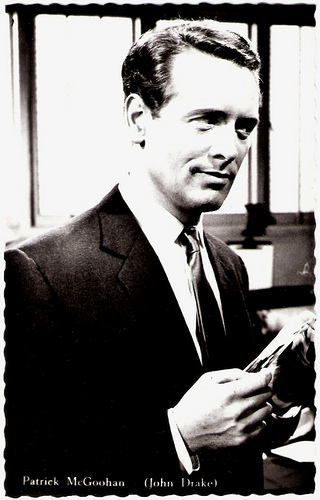
Dutch postcard. Photo: publicity still for Danger man (1960).
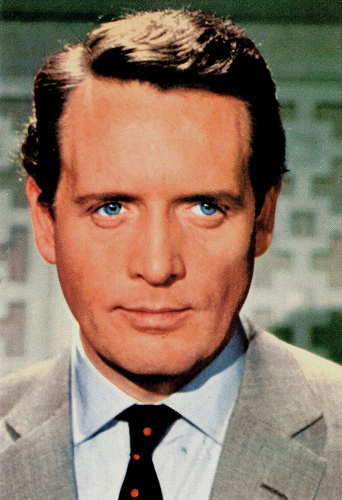
Spanish postcard by Oscar Color, Hospitalet (Barcelona), no. 612.
I am not a number - I am a free man!
Patrick Joseph McGoohan was born in Queens, New York City in 1928. His parents, the Irish immigrants Thomas McGoohan and Rose Fitzpatrick McGoohan, moved back to Ireland when he was very young and, seven years later, they moved to Sheffield, England. McGoohan thus acquired a neutral accent that sounds at home in British or American dialogue.
He left school at the age of sixteen and worked as a chicken farmer, a bank clerk and a lorry driver before getting a job as a stage manager at Sheffield Repertory Theatre. When one of the actors became ill, McGoohan filled in, launching his acting career.
McGoohan slowly graduated to small roles before eventually becoming the company's lead player. In the following years he would gain experience in repertory, the West End and the Old Vic, including leading roles in plays by Henrik Ibsen and William Shakespeare.
His first film appearances were in British productions like Passage Home (Roy Ward Baker, 1955) starring Anthony Steel , the Christopher Isherwood adaptation I Am a Camera (Henry Cornelius, 1955), and the cool action film Hell Drivers (Cy Endfield, 1957) opposite Stanley Baker .
In 1959, he won a BAFTA award for Best Television Actor for his role in The Greatest Man In The World (Ted Kotcheff, 1958), a one-off drama in ITV's Armchair Theatre series.
Shortly thereafter, he was chosen for the starring role as John Drake in Danger Man (1960-1961 and 1964-1967), which proved to be an immense successful series and allowed the British to break into the burgeoning American TV market for the first time. There it was renamed Secret Agent. McGoohan starred in 86 episodes of Danger Man, rocketing to international stardom and becoming Britain's highest-paid TV actor into the bargain, on a reputed £2,000 per week.
McGoohan then starred in, directed, produced, and wrote (as 'Paddy Fitz') many of the episodes of the ITV series The Prisoner (1967) about the efforts of a secret agent, Number Six, who resigned early in his career, to clear his name. His aim was to escape from a fancifully beautiful but psychologically brutal prison 'The Village' for people who know too much. The entire time his character attempts to find out the identity of his captor, the elusive Number One. He repeatedly declared: "I am not a number - I am a free man!"
The series was as popular as it was surreal and allegorical and its mysterious final episode caused such an uproar that McGoohan was to desert England for more than 20 years to seek relative anonymity in Hollywood.
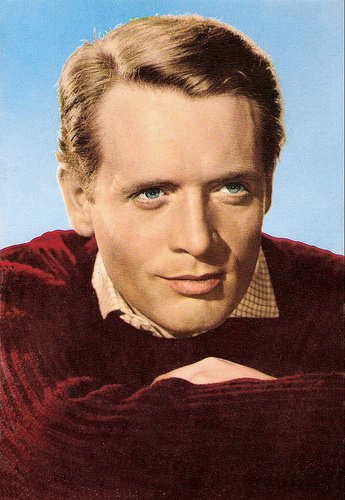
Spanish postcard by Ediciones Este, no. 141, 1966.
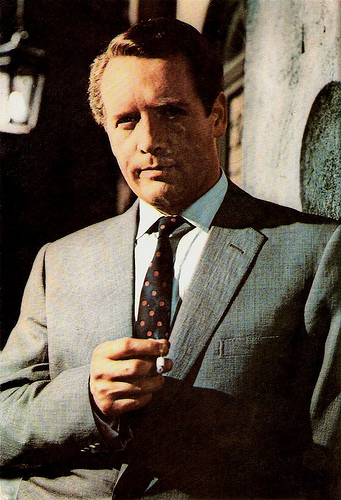
Spanish postcard by Ediciones Este, no. 149, 1966.
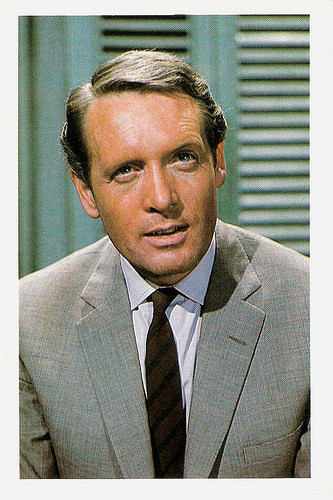
Vintage postcard. Photo: publicity still for the TV series Danger Man (1960-1961).
The Computer Wore Menace Shoes
Patrick McGoohan appeared in many films, including Ice Station Zebra (John Sturges, 1968), for which he was critically acclaimed, Mary, Queen of Scots (Charles Jarrott, 1971), with Vanessa Redgrave and Glenda Jackson , and the Sergio Leone production Un Genio, due compari, un pollo/The Genius (Damiano Damiani, 1975) starring Terence Hill .
During the 1970s, Mc Goohan appeared as a murderer in four episodes of the TV detective series Columbo, for which he won twice an Emmy Award. He also appeared in Scanners (David Cronenberg, 1981), a science fiction/horror film that has since attained cult status.
His film roles lapsed from prominence until his powerful part as King Longshanks in Mel Gibson's production of Braveheart (1995). In 1996 he appeared as Judge Omar Noose in A Time to Kill (Joel Schumacher, 1996), based on a John Grisham thriller.
In 2000, he reprised his role as Number Six in an episode of The Simpsons, 'The Computer Wore Menace Shoes'. In it, Homer Simpson concocts a news story to make his website more popular, and he wakes up in a prison disguised as a holiday resort. Dubbed Number Five, he befriends Number Six and escapes with his boat.
McGoohan's last film was a voice role in the animated film Treasure Planet (Ron Clements, John Musker, 2002). That same year, he received the Prometheus Hall of Fame Award for The Prisoner.
Patrick McGoohan died in 2009 in Santa Monica, USA, after a brief illness. That same year, Jim Caviezel played the role of Number Six in an ITV remake of The Prisoner (Nick Hurran, 2009), which also starred Sir Ian McKellen. McGoohan was married to actress Joan Drummond and they had three daughters, including actress Catherine McGoohan.
Trailer for Hell Drivers (1957). Source: Night of the Trailers (YouTube).
A complete episode of Danger Man, Position of Trust. Season 1, Episode 7, 23 October 1960. Source: Virginia Maskell S317 (YouTube).
Clip of The Prisoner (1967). Source: Polar Bear (YouTube).
Sources: Robert Sellers (The Independent), Roger Philip Mellor (Encyclopedia of British Film), AllMovie, BBC News, Wikipedia, and .

German postcard by Kolibri Verlag G.m.b.H., Minden/Westf, no. 1876. Photo: Verleih Leo J. Horster, München. Publicity still for the TV series Danger Man (1960-1961).

Dutch postcard. Photo: publicity still for Danger man (1960).

Spanish postcard by Oscar Color, Hospitalet (Barcelona), no. 612.
I am not a number - I am a free man!
Patrick Joseph McGoohan was born in Queens, New York City in 1928. His parents, the Irish immigrants Thomas McGoohan and Rose Fitzpatrick McGoohan, moved back to Ireland when he was very young and, seven years later, they moved to Sheffield, England. McGoohan thus acquired a neutral accent that sounds at home in British or American dialogue.
He left school at the age of sixteen and worked as a chicken farmer, a bank clerk and a lorry driver before getting a job as a stage manager at Sheffield Repertory Theatre. When one of the actors became ill, McGoohan filled in, launching his acting career.
McGoohan slowly graduated to small roles before eventually becoming the company's lead player. In the following years he would gain experience in repertory, the West End and the Old Vic, including leading roles in plays by Henrik Ibsen and William Shakespeare.
His first film appearances were in British productions like Passage Home (Roy Ward Baker, 1955) starring Anthony Steel , the Christopher Isherwood adaptation I Am a Camera (Henry Cornelius, 1955), and the cool action film Hell Drivers (Cy Endfield, 1957) opposite Stanley Baker .
In 1959, he won a BAFTA award for Best Television Actor for his role in The Greatest Man In The World (Ted Kotcheff, 1958), a one-off drama in ITV's Armchair Theatre series.
Shortly thereafter, he was chosen for the starring role as John Drake in Danger Man (1960-1961 and 1964-1967), which proved to be an immense successful series and allowed the British to break into the burgeoning American TV market for the first time. There it was renamed Secret Agent. McGoohan starred in 86 episodes of Danger Man, rocketing to international stardom and becoming Britain's highest-paid TV actor into the bargain, on a reputed £2,000 per week.
McGoohan then starred in, directed, produced, and wrote (as 'Paddy Fitz') many of the episodes of the ITV series The Prisoner (1967) about the efforts of a secret agent, Number Six, who resigned early in his career, to clear his name. His aim was to escape from a fancifully beautiful but psychologically brutal prison 'The Village' for people who know too much. The entire time his character attempts to find out the identity of his captor, the elusive Number One. He repeatedly declared: "I am not a number - I am a free man!"
The series was as popular as it was surreal and allegorical and its mysterious final episode caused such an uproar that McGoohan was to desert England for more than 20 years to seek relative anonymity in Hollywood.

Spanish postcard by Ediciones Este, no. 141, 1966.

Spanish postcard by Ediciones Este, no. 149, 1966.

Vintage postcard. Photo: publicity still for the TV series Danger Man (1960-1961).
The Computer Wore Menace Shoes
Patrick McGoohan appeared in many films, including Ice Station Zebra (John Sturges, 1968), for which he was critically acclaimed, Mary, Queen of Scots (Charles Jarrott, 1971), with Vanessa Redgrave and Glenda Jackson , and the Sergio Leone production Un Genio, due compari, un pollo/The Genius (Damiano Damiani, 1975) starring Terence Hill .
During the 1970s, Mc Goohan appeared as a murderer in four episodes of the TV detective series Columbo, for which he won twice an Emmy Award. He also appeared in Scanners (David Cronenberg, 1981), a science fiction/horror film that has since attained cult status.
His film roles lapsed from prominence until his powerful part as King Longshanks in Mel Gibson's production of Braveheart (1995). In 1996 he appeared as Judge Omar Noose in A Time to Kill (Joel Schumacher, 1996), based on a John Grisham thriller.
In 2000, he reprised his role as Number Six in an episode of The Simpsons, 'The Computer Wore Menace Shoes'. In it, Homer Simpson concocts a news story to make his website more popular, and he wakes up in a prison disguised as a holiday resort. Dubbed Number Five, he befriends Number Six and escapes with his boat.
McGoohan's last film was a voice role in the animated film Treasure Planet (Ron Clements, John Musker, 2002). That same year, he received the Prometheus Hall of Fame Award for The Prisoner.
Patrick McGoohan died in 2009 in Santa Monica, USA, after a brief illness. That same year, Jim Caviezel played the role of Number Six in an ITV remake of The Prisoner (Nick Hurran, 2009), which also starred Sir Ian McKellen. McGoohan was married to actress Joan Drummond and they had three daughters, including actress Catherine McGoohan.
Trailer for Hell Drivers (1957). Source: Night of the Trailers (YouTube).
A complete episode of Danger Man, Position of Trust. Season 1, Episode 7, 23 October 1960. Source: Virginia Maskell S317 (YouTube).
Clip of The Prisoner (1967). Source: Polar Bear (YouTube).
Sources: Robert Sellers (The Independent), Roger Philip Mellor (Encyclopedia of British Film), AllMovie, BBC News, Wikipedia, and .
Published on September 15, 2018 22:00
September 14, 2018
Photo by Atelier Eberth
In her Berlin studio, German photographer Anny Eberth portrayed aristocratic ladies and elegant fashion models, but also film actors and expressionist dancers, including the notorious Anita Berber. During the 1910s and 1920s, her photos were published in such Berlin magazines as Die Dame and Berliner Illustrierte Zeitung, and were used for many sepia film star postcards. For this post on Atelier Eberth, we selected 15 postcards with female portraits.
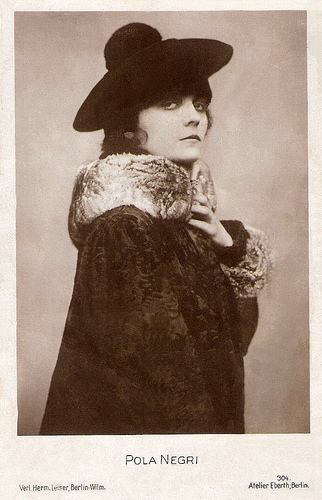
Pola Negri . German postcard by Verlag Hermann Leiser, Berlin-Wilm., no. 304. Photo: Atelier Eberth, Berlin.
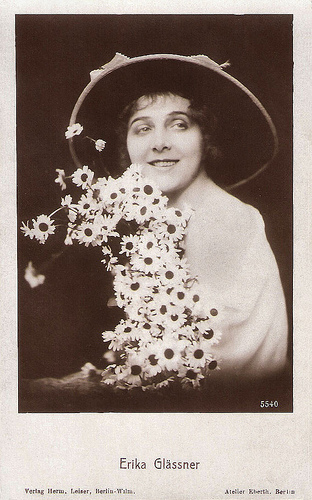
Erika Glässner . German postcard by Hermann Leiser, Berlin-Wilm, no. 5540. Photo: Atelier Eberth, Berlin.
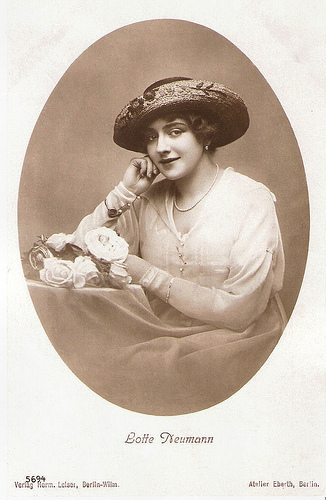
Lotte Neumann . German postcard by Verlag Hermann Leiser, Berlin-Wilm., no. 5694. Photo: Eberth, Berlin.
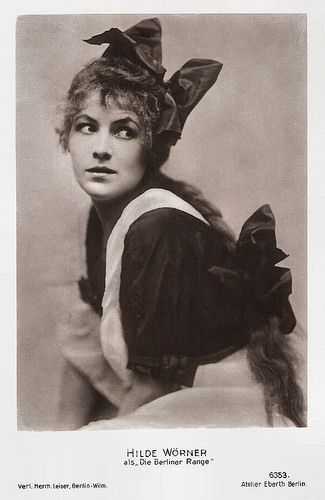
Hilde Wörner . German postcard by Verlag Hermann Leiser, Berlin, no. 6253. Photo: Atelier Eberth, Berlin. Publicity still for Die Berliner Range/The Berlin Urchin (Max Mack, 1913).
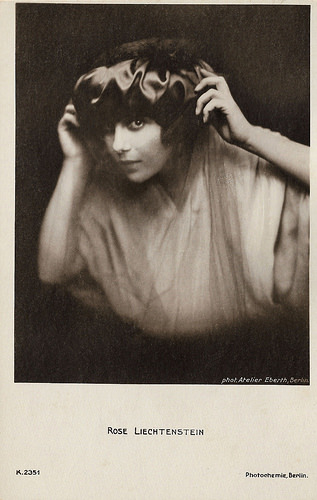
Rose Liechtenstein. German postcard by Photochemie, Berlin, no. K. 2351. Photo: Atelier Eberth, Berlin.
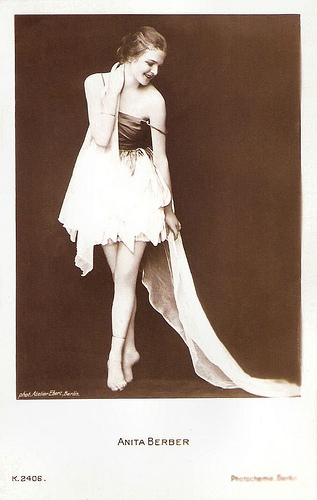
Anita Berber . German postcard by Photochemie, Berlin, no. K. 2406. Photo: Atelier Eberth, Berlin.
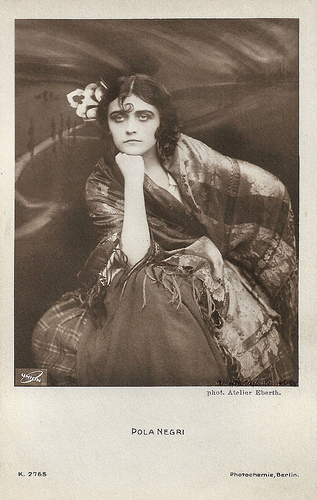
German postcard by Photochemie, Berlin, no. K. 2765. Photo: Atelier Eberth / Union. Pola Negri as Carmen in the German silent drama Carmen (Ernst Lubitsch, 1918).
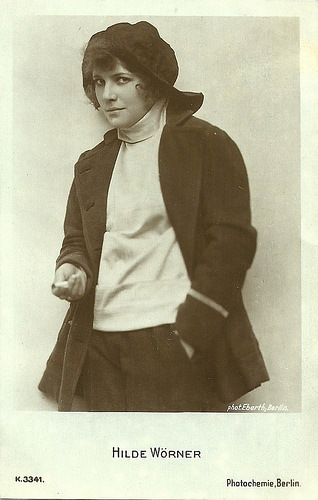
Hilde Wörner . German postcard by Photochemie, no. K. 3341. Photo: Eberth, Berlin.
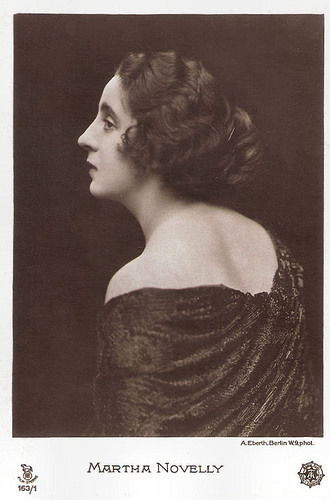
Martha Novelly . German postcard in the Film-Sterne series by Rotophot, no. 163/1. Photo: A. Eberth, Berlin / Astra Film.
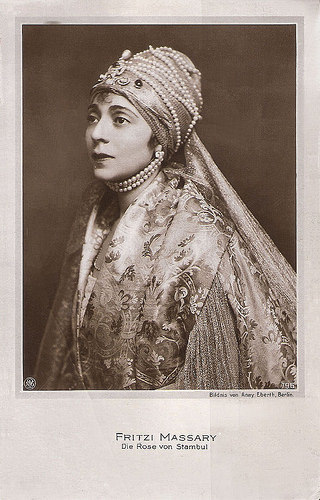
Fritzi Massary. German postcard by NPG, no. 795. Photo: Anny Eberth, Berlin. Publicity still for Die Rose von Stambul/The Rose of Stamboul (Felix Basch, Arthur Wellin, 1919).
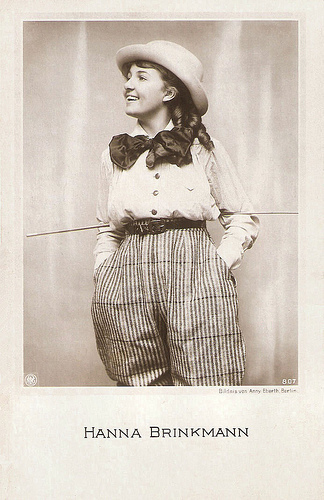
Hanne Brinkmann . German postcard by NPG, no. 807. Photo: Anny Eberth, Berlin.
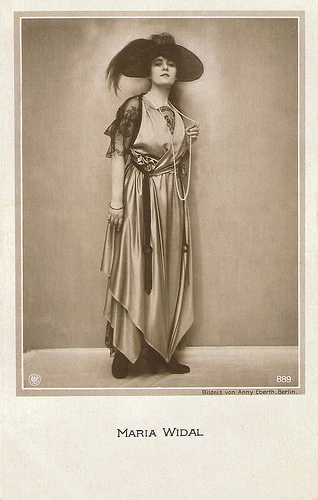
Maria Widal . German postcard by NPG, no. 889. Photo: Anny Eberth, Berlin.
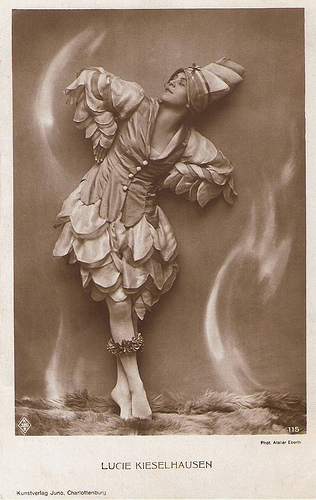
Lucie Kieselhausen. German postcard by Kunstverlag Juno, Charlottenburg, no. 115. Photo: Atelier Eberth.
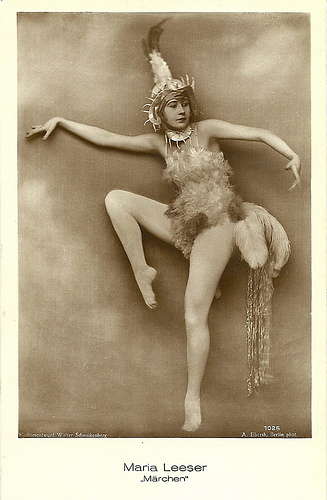
Maria Leeser. German postcard, no. 1025. Photo: A. Eberth, Berlin. Costume design: Walter Schnackenberg. Caption: Märchen (Fairytales). Collection: Didier Hanson.

Aud Egede Nissen . German postcard by Ross Verlag, no. 476/1, 1919-1924. Photo: A. Eberth, Berlin.
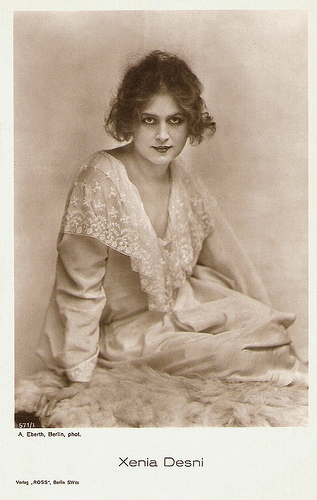
Xenia Desni . German postcard by Ross Verlag, no. 571/1, 1919-1924. Photo: A. Eberth, Berlin.
Sources: Europeana Collection and Getty Images.

Pola Negri . German postcard by Verlag Hermann Leiser, Berlin-Wilm., no. 304. Photo: Atelier Eberth, Berlin.

Erika Glässner . German postcard by Hermann Leiser, Berlin-Wilm, no. 5540. Photo: Atelier Eberth, Berlin.

Lotte Neumann . German postcard by Verlag Hermann Leiser, Berlin-Wilm., no. 5694. Photo: Eberth, Berlin.

Hilde Wörner . German postcard by Verlag Hermann Leiser, Berlin, no. 6253. Photo: Atelier Eberth, Berlin. Publicity still for Die Berliner Range/The Berlin Urchin (Max Mack, 1913).

Rose Liechtenstein. German postcard by Photochemie, Berlin, no. K. 2351. Photo: Atelier Eberth, Berlin.

Anita Berber . German postcard by Photochemie, Berlin, no. K. 2406. Photo: Atelier Eberth, Berlin.

German postcard by Photochemie, Berlin, no. K. 2765. Photo: Atelier Eberth / Union. Pola Negri as Carmen in the German silent drama Carmen (Ernst Lubitsch, 1918).

Hilde Wörner . German postcard by Photochemie, no. K. 3341. Photo: Eberth, Berlin.

Martha Novelly . German postcard in the Film-Sterne series by Rotophot, no. 163/1. Photo: A. Eberth, Berlin / Astra Film.

Fritzi Massary. German postcard by NPG, no. 795. Photo: Anny Eberth, Berlin. Publicity still for Die Rose von Stambul/The Rose of Stamboul (Felix Basch, Arthur Wellin, 1919).

Hanne Brinkmann . German postcard by NPG, no. 807. Photo: Anny Eberth, Berlin.

Maria Widal . German postcard by NPG, no. 889. Photo: Anny Eberth, Berlin.

Lucie Kieselhausen. German postcard by Kunstverlag Juno, Charlottenburg, no. 115. Photo: Atelier Eberth.

Maria Leeser. German postcard, no. 1025. Photo: A. Eberth, Berlin. Costume design: Walter Schnackenberg. Caption: Märchen (Fairytales). Collection: Didier Hanson.

Aud Egede Nissen . German postcard by Ross Verlag, no. 476/1, 1919-1924. Photo: A. Eberth, Berlin.

Xenia Desni . German postcard by Ross Verlag, no. 571/1, 1919-1924. Photo: A. Eberth, Berlin.
Sources: Europeana Collection and Getty Images.
Published on September 14, 2018 22:00
September 13, 2018
Angelika Waller
East German actress Angelika Waller (1944) appeared in more than hundred films and TV productions since 1962. Her first leading role was in Das Kaninchen bin ich/The Rabbit Is Me (1965), a film which was banned in East Germany and which had its world premiere only in 1989.
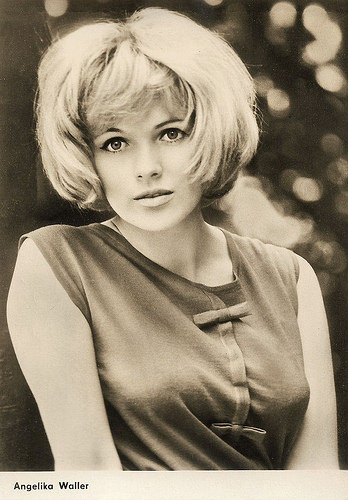
East-German postcard by VEB Progress Film-Vertrieb, Berlin, no. 2675, 1966 Photo: Balinski.

Big East-German card by VEB Progress Film-Vertrieb, Berlin, no. 2985, 1967. Photo: Balinski.
The rabbit I am
Angelika Waller was born in 1944 in Bärwalde in der Neumark in former East-Germany (GDR). She went to school in Biesenthal in Brandenburg. As a kid, she already developed an interest in acting.
From 1963 to 1966 she was trained as an actress at the youth studio of the Deutscher Fernsehfunk (DFF), the former state television broadcaster in East Germany. To finance her studies, she worked as an ice cream seller and furniture painter.
In 1965, Helene Weigel took her to the Berliner Ensemble, and since 1966 she has been a member of the theatre company. She made her stage debut in the comedy Frau Flinz by Helmut Baierl. She appeared in several Bertolt Brecht plays, including as Polly in Brecht's Dreigroschenoper (Threepenny Opera).
Her film debut is also her most famous role, which was only made public in 1989 (some sources say 1990). The film, Das Kaninchen bin ich/The Rabbit I Am (Kurt Maetzig, 1965) came in the GDR on the index.
Waller played 19-year-old Maria Morzeck, who dreams of studying Slavistics, but her hopes are shattered when her brother, Dieter, is sent to prison after being convicted of sedition against the state. She cannot enter college, and becomes a waitress. Maria meets and falls in love with Paul Deister, an older, married man who turns out to be the judge who convicted her brother. Their affair ends when Deister is exposed as hypocritical and corrupt. After Dieter's release, he learns of his sister's relationship with the judge and assaults her. Eventually, Maria distances herself from both of them, and decides to pursue her forgotten dream.
The film was based on Manfred Bieler's book Maria Morzeck or the Rabbit is Me. It was filmed in the aftermath of the VI Party Congress of the Socialist Unity Party at January 1963, during which the establishment allowed a measure of liberalisation in the cultural life of East Germany. Although Bieler's novel was highly critical of the court system, he and director Maetzig took care to include several 'alibi scenes' in the film that were intended to put the state in a better light and also prevent the banning of the picture. The scenes were also meant to present the judicial reforms that took place between 1961 and 1963.
The short era of liberalisation ended gradually when Leonid Brezhnev took power in the Soviet Union and introduced a conservative, more repressive course on cultural questions. Das Kaninchen bin ich, alongside eleven other films that were deemed politically damaging, was banned in 1965. In 1989, shortly before the collapse of the Eastern Bloc, the picture had finally its world premiere and was released for public screening. It was presented at the Berlin and Locarno film festivals, and was elected as one of the 100 most important German films by a group of historians and critics in 1995.
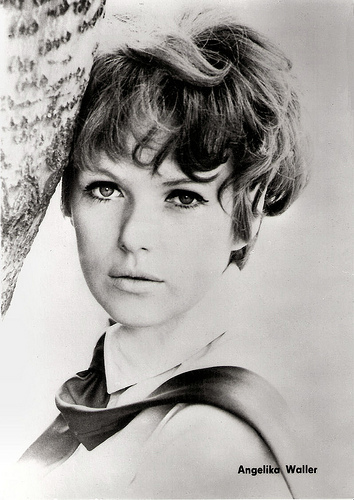
Big East-German card by VEB Progress Film-Vertrieb, Berlin, no. 3203, 1968. Photo: Balinski.
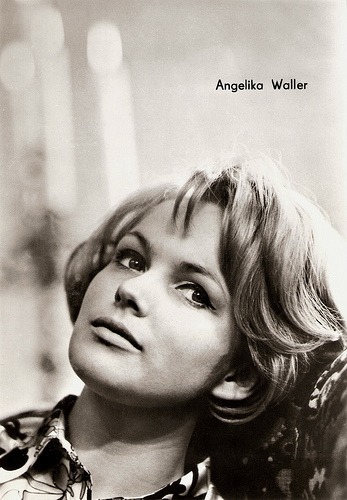
Big East-German card by VEB Progress Film-Vertrieb, Berlin, no. 187/70. Photo: Uhlenhut.
Hitler's mistress
Angelika Waller became a crowd favourite with her second film, the circus film Schwarze Panther/Black Panthers (Josef Mach, 1966). She played the young Martina, who, despite the opposition of her father, tames the panthers in the circus ring and, according to Filmportal.de , “she impresses, among other things, by her artistic talent.”
In subsequent years, she is seen in numerous films in larger and smaller roles, repeatedly under the direction of Rolf Losansky. In the epic film series Osvobozhdenie/Liberation (Juri Oserow, Julius Kun, 1969-1970), Waller played Hitler’s mistress Eva Braun. The five-part film series is a dramatised account of the liberation of the Soviet Union's territory during World War II and the subsequent defeat of Nazi Germany. The series was a Soviet-Polish-East German-Italian-Yugoslav co-production and according to official Soviet statistics, Liberation sold more than 400 million tickets worldwide. In the English-speaking world, a shorter, 118-minutes long version was distributed as The Great Battle.
In the meanwhile, the DEFA studio gave Waller only a few meaty parts, in which she could present her many acting facets, but the television offered her more possibilities. At the East-German television, she could convince in modern women's roles. She embodied emancipated women who decide for themselves in difficult situations. An extremely popular role was the title heroine - a postwoman - in the TV film Rotfuchs/Red Fox (Manfred Mosblech, 1973).
Angelika Waller also regularly played in the Krimi series Polizeiruf 110/Police Call 110 (1972-1987). Very popular was also the TV series Johann Sebastian Bach (1985) in which she played Bach's first wife. Since the 1970s, she worked as a teacher, and later as a professor at the Hochschule für Schauspielkunst 'Ernst Busch' Berlin (Academy of Dramatic Arts Ernst Busch in Berlin). She also worked as a director and staged plays at the Berliner Arbeiter-Theater.
Until 1992, she remained a member of the Berliner Ensemble. In 1990, she returned to the cinema in the post-war comedy Der Bruch/The Break-In (Frank Beyer, 1990) alongside Götz George , Rolf Hoppe and Otto Sander. Waller played a busty woman, cheated by her spouse, who clearly expresses her material wishes. Next, she appeared in two TV films, the comedy Baby-sitter/Babysitter (Peter Welz, 1992) and again together with Götz George - in Tote sterben niemals aus/Dead people never die out (Jürgen Goslar, 1996). She starred in the role of Omi in the experimental film Happiness Is a Warm Gun (Thomas Imbach, 2001) on Petra Kelly and Gert Bastian.
In addition, she also lent her voice as a voice actor to among others Geneviève Bujold in the TV film Anthony and Cleopatra (James Cellan Jones, 1976) and Linda Purl in the TV mini-series The last days of Pompeii (Peter R. Hunt, 1984). In 1978 she received the Art Prize of the GDR. Since 2010 Waller has been a regular guest lecturer at the Thomas Bernhard Institute for Acting and Directing at the Mozarteum in Salzburg.
Most recently, she appeared in the cinemas as the grandmother in Rückenwind von vorn/Away You Go (Philipp Eichholtz, 2018). Angelika Waller lives in Berlin. Her daughter Susann Thiede (born 1963) also works as an actress.

East-German postcard by VEB Progress Film-Vertrieb, Berlin, no. 128/74, 1974. Photo: Linke.
Sources: Ines Walk (Filmzeit.de– German), Wikipedia (German and English) and .

East-German postcard by VEB Progress Film-Vertrieb, Berlin, no. 2675, 1966 Photo: Balinski.

Big East-German card by VEB Progress Film-Vertrieb, Berlin, no. 2985, 1967. Photo: Balinski.
The rabbit I am
Angelika Waller was born in 1944 in Bärwalde in der Neumark in former East-Germany (GDR). She went to school in Biesenthal in Brandenburg. As a kid, she already developed an interest in acting.
From 1963 to 1966 she was trained as an actress at the youth studio of the Deutscher Fernsehfunk (DFF), the former state television broadcaster in East Germany. To finance her studies, she worked as an ice cream seller and furniture painter.
In 1965, Helene Weigel took her to the Berliner Ensemble, and since 1966 she has been a member of the theatre company. She made her stage debut in the comedy Frau Flinz by Helmut Baierl. She appeared in several Bertolt Brecht plays, including as Polly in Brecht's Dreigroschenoper (Threepenny Opera).
Her film debut is also her most famous role, which was only made public in 1989 (some sources say 1990). The film, Das Kaninchen bin ich/The Rabbit I Am (Kurt Maetzig, 1965) came in the GDR on the index.
Waller played 19-year-old Maria Morzeck, who dreams of studying Slavistics, but her hopes are shattered when her brother, Dieter, is sent to prison after being convicted of sedition against the state. She cannot enter college, and becomes a waitress. Maria meets and falls in love with Paul Deister, an older, married man who turns out to be the judge who convicted her brother. Their affair ends when Deister is exposed as hypocritical and corrupt. After Dieter's release, he learns of his sister's relationship with the judge and assaults her. Eventually, Maria distances herself from both of them, and decides to pursue her forgotten dream.
The film was based on Manfred Bieler's book Maria Morzeck or the Rabbit is Me. It was filmed in the aftermath of the VI Party Congress of the Socialist Unity Party at January 1963, during which the establishment allowed a measure of liberalisation in the cultural life of East Germany. Although Bieler's novel was highly critical of the court system, he and director Maetzig took care to include several 'alibi scenes' in the film that were intended to put the state in a better light and also prevent the banning of the picture. The scenes were also meant to present the judicial reforms that took place between 1961 and 1963.
The short era of liberalisation ended gradually when Leonid Brezhnev took power in the Soviet Union and introduced a conservative, more repressive course on cultural questions. Das Kaninchen bin ich, alongside eleven other films that were deemed politically damaging, was banned in 1965. In 1989, shortly before the collapse of the Eastern Bloc, the picture had finally its world premiere and was released for public screening. It was presented at the Berlin and Locarno film festivals, and was elected as one of the 100 most important German films by a group of historians and critics in 1995.

Big East-German card by VEB Progress Film-Vertrieb, Berlin, no. 3203, 1968. Photo: Balinski.

Big East-German card by VEB Progress Film-Vertrieb, Berlin, no. 187/70. Photo: Uhlenhut.
Hitler's mistress
Angelika Waller became a crowd favourite with her second film, the circus film Schwarze Panther/Black Panthers (Josef Mach, 1966). She played the young Martina, who, despite the opposition of her father, tames the panthers in the circus ring and, according to Filmportal.de , “she impresses, among other things, by her artistic talent.”
In subsequent years, she is seen in numerous films in larger and smaller roles, repeatedly under the direction of Rolf Losansky. In the epic film series Osvobozhdenie/Liberation (Juri Oserow, Julius Kun, 1969-1970), Waller played Hitler’s mistress Eva Braun. The five-part film series is a dramatised account of the liberation of the Soviet Union's territory during World War II and the subsequent defeat of Nazi Germany. The series was a Soviet-Polish-East German-Italian-Yugoslav co-production and according to official Soviet statistics, Liberation sold more than 400 million tickets worldwide. In the English-speaking world, a shorter, 118-minutes long version was distributed as The Great Battle.
In the meanwhile, the DEFA studio gave Waller only a few meaty parts, in which she could present her many acting facets, but the television offered her more possibilities. At the East-German television, she could convince in modern women's roles. She embodied emancipated women who decide for themselves in difficult situations. An extremely popular role was the title heroine - a postwoman - in the TV film Rotfuchs/Red Fox (Manfred Mosblech, 1973).
Angelika Waller also regularly played in the Krimi series Polizeiruf 110/Police Call 110 (1972-1987). Very popular was also the TV series Johann Sebastian Bach (1985) in which she played Bach's first wife. Since the 1970s, she worked as a teacher, and later as a professor at the Hochschule für Schauspielkunst 'Ernst Busch' Berlin (Academy of Dramatic Arts Ernst Busch in Berlin). She also worked as a director and staged plays at the Berliner Arbeiter-Theater.
Until 1992, she remained a member of the Berliner Ensemble. In 1990, she returned to the cinema in the post-war comedy Der Bruch/The Break-In (Frank Beyer, 1990) alongside Götz George , Rolf Hoppe and Otto Sander. Waller played a busty woman, cheated by her spouse, who clearly expresses her material wishes. Next, she appeared in two TV films, the comedy Baby-sitter/Babysitter (Peter Welz, 1992) and again together with Götz George - in Tote sterben niemals aus/Dead people never die out (Jürgen Goslar, 1996). She starred in the role of Omi in the experimental film Happiness Is a Warm Gun (Thomas Imbach, 2001) on Petra Kelly and Gert Bastian.
In addition, she also lent her voice as a voice actor to among others Geneviève Bujold in the TV film Anthony and Cleopatra (James Cellan Jones, 1976) and Linda Purl in the TV mini-series The last days of Pompeii (Peter R. Hunt, 1984). In 1978 she received the Art Prize of the GDR. Since 2010 Waller has been a regular guest lecturer at the Thomas Bernhard Institute for Acting and Directing at the Mozarteum in Salzburg.
Most recently, she appeared in the cinemas as the grandmother in Rückenwind von vorn/Away You Go (Philipp Eichholtz, 2018). Angelika Waller lives in Berlin. Her daughter Susann Thiede (born 1963) also works as an actress.

East-German postcard by VEB Progress Film-Vertrieb, Berlin, no. 128/74, 1974. Photo: Linke.
Sources: Ines Walk (Filmzeit.de– German), Wikipedia (German and English) and .
Published on September 13, 2018 22:00
September 12, 2018
Michel Strogoff (1926)
Ivan Mozzhukhin and Nathalie Kovanko were the stars of the French-German silent film Michel Strogoff (Victor Tourjansky, 1926), based on Jules Verne's classic novel. In many European countries, postcards were published for this classic adventure film.
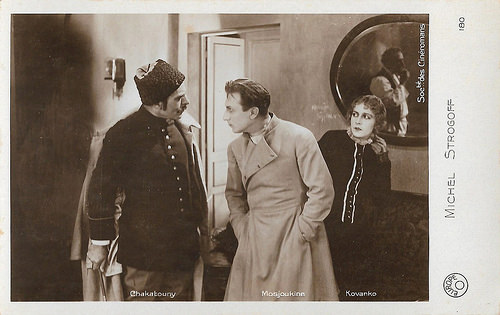
French postcard by Europe, no. 180. Photo: Société des Cinéromans. Ivan Mozzhukhin , Nathalie Kovanko and Acho Chakatouny in Michel Strogoff (Victor Tourjansky, 1926).
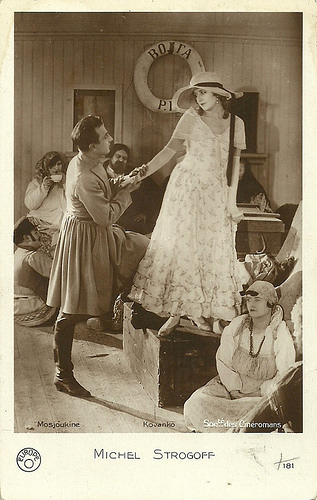
French postcard by Europe, no. 181. Photo: Société des Cinéromans. Ivan Mozzhukhin and Nathalie Kovanko in Michel Strogoff (Viktor Tourjansky, 1926).
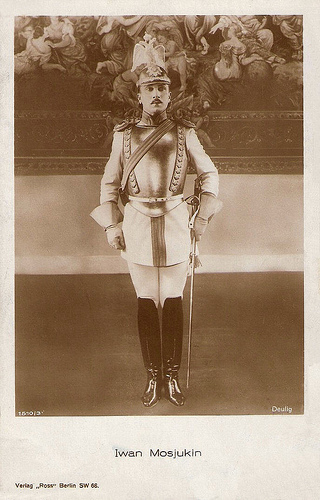
German postcard by Ross Verlag, no. 1510/3, 1927-1928. Photo: Deulig. Ivan Mozzhukhin in Michel Strogoff (Victor Tourjansky, 1926).
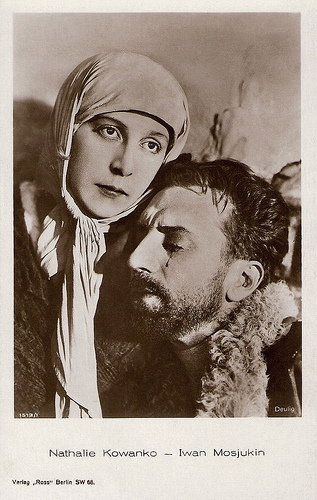
German postcard by Ross Verlag, no. 1512/1, 1927-1928. Photo: Deulig. Postcard for Michel Strogoff (Viktor Tourjansky, 1926). Nadia Fedor ( Nathalie Kovanko ) consoles Michel Strogoff ( Ivan Mozzhukhin ) after he is blinded.
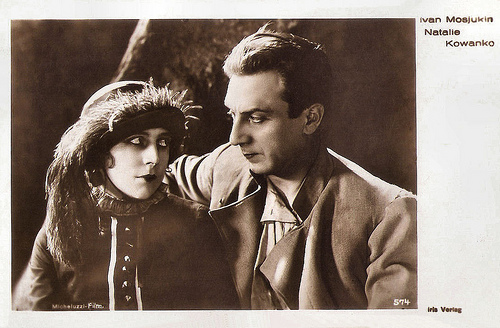
Austrian postcard by Iris-Verlag no. 574. Photo: Micheluzzi-Film. Ivan Mozzhukhin and Nathalie Kovanko in Michel Strogoff (Viktor Tourjansky, 1926).
A magnetic hold on our attention
Jules Verne wrote Michel Strogoff/Michael Strogoff: The Courier of the Czar in 1876, and it is considered one of his best books. The book was later adapted to a play, by Verne himself and Adolphe d'Ennery. Incidental music to the play was written by Alexandre Artus in 1880. The book has been adapted several times for films, television and even cartoon series.
One of the best versions is this French-German silent film, made by exiles from the Russian Revolution of 1917 under direction of Victor Tourjansky, shortly before his emigration to Hollywood. The film's art direction was by Eduardo Gosch, César Lacca, Alexandre Lochakoff, Vladimir Meingard and Pierre Schild who recreated the atmosphere of the mid-nineteenth century Russian Empire.
Tourjansky's screenplay follows the Jules Verne novel to the letter. In 1860s Russia, invading Tartars cut off all telecommunications between the border cities and the capital. The czar (Vladimir Gajdarov) sends the young captain Michael Strogoff ( Ivan Mozzhukhin ) to deliver a vital message to the last line of defence. Along the way he finds love with the practical Nadia ( Nathalie Kovanko ), a woman trying to visit her exiled father in Siberia, and danger from the traitorous Ivan Ogareff (Acho Chakatouny), who wants to stop him at all costs. Hal Erickson at AllMovie : "Strogoff is captured by The Grand Khan (Boris de Fas), who prepares to shove hot pokers in the hero's eyes while Strogoff's mother (Jeanne Brindeau) looks on helplessly. Despite these and other perils, Strogoff completes his mission and wins the hand of the beautiful Nadia."
Michel Strogoff (Viktor Tourjansky, 1926) was a co-production by Ciné France, Deulig Europa-Produktion and Films de France. A huge production, easily rivalling Hollywood's biggest, it represents the European film industry at it's most accomplished. 4,000 soldiers, including cavalrymen, were loaned by the Latvian army to portray the Russian and Tartar armies, and the battles were filmed outside Riga on large plains, which simulated the Siberian steppes.
The result is a wonderfully exciting historical adventure, full of epic sweep, pulsating action, intrigue, romance and even a little comedy relief. The silent film was a big hit in it's time. Despite a 3 hour length, the pace never lags and the story is compelling throughout. Technically the film was cutting edge 1926-style, with it's use of colour and tinting and some dazzling editing of the type associated with Abel Gance and Sergei Eisenstein.
Another strong asset of the film is the charismatic performance of Ivan Mozhukhin, who according to reviewer Hamilton65 at IMDb "draws us effortlessly into Strogoff's mission to reach the Tsar in time to save the empire from the Tartars. From his first appearance Mozhukhin exerts a magnetic hold on our attention. He never overplays, yet conveys a wide range of emotions and thoughts with the subtlest of movements."
With the coming of sound, Michel Strogoff (Viktor Tourjansky, 1926) got virtually forgotten. Renée Lichtig made for the Cinémathèque française a superb restoration which returned the film to it's proper state.
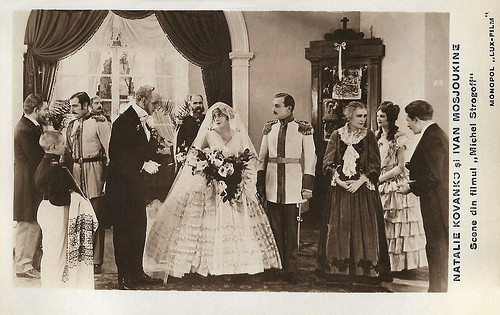
Romanian postcard by Editura Librariei SOCEC & Co. S.A., Bucuresti, no. 53. Photo: Monopol "Lux-Film". Ivan Mozzhukhin and Nathalie Kovanko in Michel Strogoff (Viktor Tourjansky, 1926).
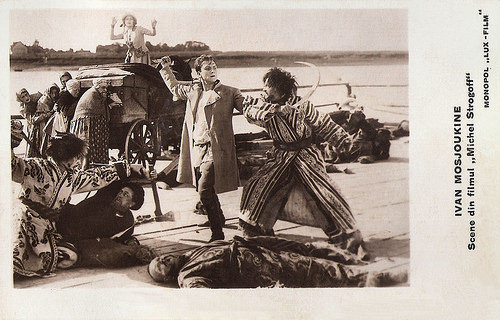
Romanian postcard by Editura Librariei SOCEC & Co. S.A., Bucuresti. Photo: Monopol "Lux-Film". Ivan Mozzhukhin in Michel Strogoff (Victor Tourjansky, 1926).
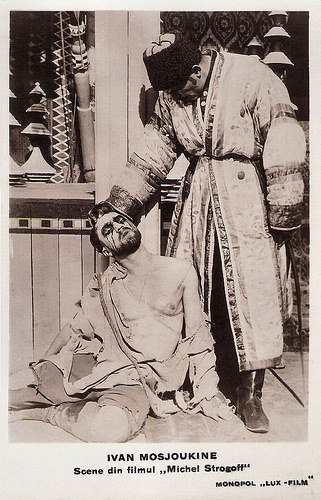
Romanian postcard by Editura Librariei SOCEC & Co. S.A., Bucuresti. Photo: Monopol "Lux-Film". Ivan Mozzhukhin in Michel Strogoff (Victor Tourjansky, 1926).
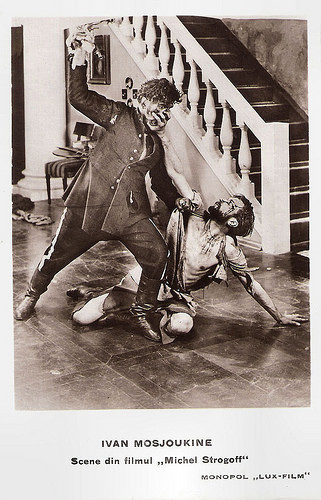
Romanian postcard by Editura Librariei SOCEC & Co. S.A., Bucuresti. Photo: Monopol "Lux-Film". Ivan Mozzhukhin in Michel Strogoff (Victor Tourjansky, 1926).
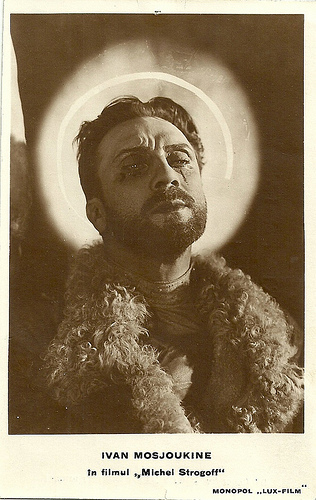
Romanian postcard by Editura Librariei SOCEC & Co. S.A., Bucuresti. Photo: Monopol "Lux-Film". Ivan Mozzhukhin in Michel Strogoff (Victor Tourjansky, 1926).
The restored version of Michel Strogoff (1926). Source: Peliculas Mudas/Silent Films (YouTube).
A rough transfer of the ballroom scene from Michel Strogoff (1926) from a 9.5m print, including a section missing from the restoration. The score is Glinka's Valse Fantasie. Source: Christopher Bird (YouTube).
Sources: Hamilton65 (IMDb), Hal Erickson (AllMovie), Wikipedia and IMDb.

French postcard by Europe, no. 180. Photo: Société des Cinéromans. Ivan Mozzhukhin , Nathalie Kovanko and Acho Chakatouny in Michel Strogoff (Victor Tourjansky, 1926).

French postcard by Europe, no. 181. Photo: Société des Cinéromans. Ivan Mozzhukhin and Nathalie Kovanko in Michel Strogoff (Viktor Tourjansky, 1926).

German postcard by Ross Verlag, no. 1510/3, 1927-1928. Photo: Deulig. Ivan Mozzhukhin in Michel Strogoff (Victor Tourjansky, 1926).

German postcard by Ross Verlag, no. 1512/1, 1927-1928. Photo: Deulig. Postcard for Michel Strogoff (Viktor Tourjansky, 1926). Nadia Fedor ( Nathalie Kovanko ) consoles Michel Strogoff ( Ivan Mozzhukhin ) after he is blinded.

Austrian postcard by Iris-Verlag no. 574. Photo: Micheluzzi-Film. Ivan Mozzhukhin and Nathalie Kovanko in Michel Strogoff (Viktor Tourjansky, 1926).
A magnetic hold on our attention
Jules Verne wrote Michel Strogoff/Michael Strogoff: The Courier of the Czar in 1876, and it is considered one of his best books. The book was later adapted to a play, by Verne himself and Adolphe d'Ennery. Incidental music to the play was written by Alexandre Artus in 1880. The book has been adapted several times for films, television and even cartoon series.
One of the best versions is this French-German silent film, made by exiles from the Russian Revolution of 1917 under direction of Victor Tourjansky, shortly before his emigration to Hollywood. The film's art direction was by Eduardo Gosch, César Lacca, Alexandre Lochakoff, Vladimir Meingard and Pierre Schild who recreated the atmosphere of the mid-nineteenth century Russian Empire.
Tourjansky's screenplay follows the Jules Verne novel to the letter. In 1860s Russia, invading Tartars cut off all telecommunications between the border cities and the capital. The czar (Vladimir Gajdarov) sends the young captain Michael Strogoff ( Ivan Mozzhukhin ) to deliver a vital message to the last line of defence. Along the way he finds love with the practical Nadia ( Nathalie Kovanko ), a woman trying to visit her exiled father in Siberia, and danger from the traitorous Ivan Ogareff (Acho Chakatouny), who wants to stop him at all costs. Hal Erickson at AllMovie : "Strogoff is captured by The Grand Khan (Boris de Fas), who prepares to shove hot pokers in the hero's eyes while Strogoff's mother (Jeanne Brindeau) looks on helplessly. Despite these and other perils, Strogoff completes his mission and wins the hand of the beautiful Nadia."
Michel Strogoff (Viktor Tourjansky, 1926) was a co-production by Ciné France, Deulig Europa-Produktion and Films de France. A huge production, easily rivalling Hollywood's biggest, it represents the European film industry at it's most accomplished. 4,000 soldiers, including cavalrymen, were loaned by the Latvian army to portray the Russian and Tartar armies, and the battles were filmed outside Riga on large plains, which simulated the Siberian steppes.
The result is a wonderfully exciting historical adventure, full of epic sweep, pulsating action, intrigue, romance and even a little comedy relief. The silent film was a big hit in it's time. Despite a 3 hour length, the pace never lags and the story is compelling throughout. Technically the film was cutting edge 1926-style, with it's use of colour and tinting and some dazzling editing of the type associated with Abel Gance and Sergei Eisenstein.
Another strong asset of the film is the charismatic performance of Ivan Mozhukhin, who according to reviewer Hamilton65 at IMDb "draws us effortlessly into Strogoff's mission to reach the Tsar in time to save the empire from the Tartars. From his first appearance Mozhukhin exerts a magnetic hold on our attention. He never overplays, yet conveys a wide range of emotions and thoughts with the subtlest of movements."
With the coming of sound, Michel Strogoff (Viktor Tourjansky, 1926) got virtually forgotten. Renée Lichtig made for the Cinémathèque française a superb restoration which returned the film to it's proper state.

Romanian postcard by Editura Librariei SOCEC & Co. S.A., Bucuresti, no. 53. Photo: Monopol "Lux-Film". Ivan Mozzhukhin and Nathalie Kovanko in Michel Strogoff (Viktor Tourjansky, 1926).

Romanian postcard by Editura Librariei SOCEC & Co. S.A., Bucuresti. Photo: Monopol "Lux-Film". Ivan Mozzhukhin in Michel Strogoff (Victor Tourjansky, 1926).

Romanian postcard by Editura Librariei SOCEC & Co. S.A., Bucuresti. Photo: Monopol "Lux-Film". Ivan Mozzhukhin in Michel Strogoff (Victor Tourjansky, 1926).

Romanian postcard by Editura Librariei SOCEC & Co. S.A., Bucuresti. Photo: Monopol "Lux-Film". Ivan Mozzhukhin in Michel Strogoff (Victor Tourjansky, 1926).

Romanian postcard by Editura Librariei SOCEC & Co. S.A., Bucuresti. Photo: Monopol "Lux-Film". Ivan Mozzhukhin in Michel Strogoff (Victor Tourjansky, 1926).
The restored version of Michel Strogoff (1926). Source: Peliculas Mudas/Silent Films (YouTube).
A rough transfer of the ballroom scene from Michel Strogoff (1926) from a 9.5m print, including a section missing from the restoration. The score is Glinka's Valse Fantasie. Source: Christopher Bird (YouTube).
Sources: Hamilton65 (IMDb), Hal Erickson (AllMovie), Wikipedia and IMDb.
Published on September 12, 2018 22:00
September 11, 2018
Giovanni Grasso
Giovanni Grasso (1873-1930) was an Italian stage and screen actor. While he was seen as the best Sicilian tragic actor and one of the best in Italy, he also had limited but very important career in Italian silent cinema. Sadly, all of Grasso's films were considered lost, but in 2005 fortune smiled at us...
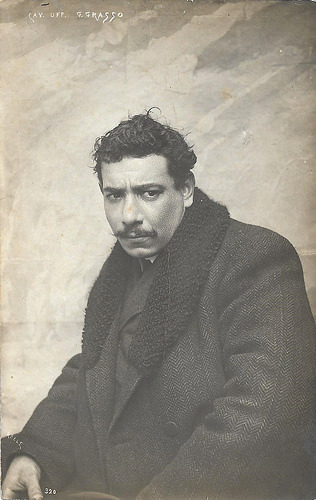
Italian postcard, no. 320. Photo: Photo Reale.
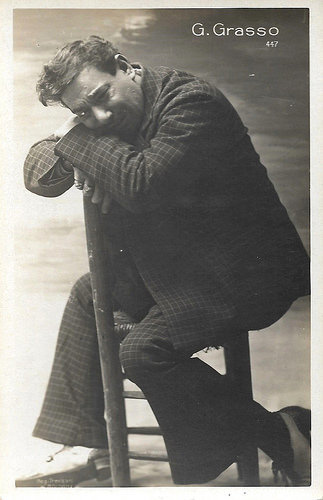
Italian postcard by Ed. Vettori, Bologna, no. 447.
Nature as a mirror
Giovanni Grasso was born in Catania, Sicily, in 1873, as the son of puppet master Angelo Grasso and his second wife Ciccia (Francesca) Tudisco, who was a puppet master too. From Naples, Angelo Grasso’s father supposedly introduced the puppet theatre in Catania. Angelo opened a small puppet theatre in Catania, Teatro Machiavelli.
After Angelo's death, his family turned it into a vaudeville theatre in order to survive. Small provincial companies stopped there, alternating edifying dramas with farces and subject performances ('scenoni'), inspired by news events. In this eclectic environment of the 1890s, young Giovanni Grasso was trained as a man of the theatre.
He decided to brush up his paternal puppets, presenting – successful - shows. Among his greatest admirers was the playwright and journalist Nino Martoglio, who led the famous actor Ernesto Rossi to the Machiavelli. At the end of the show, Rossi, dazed by the expressive power of the puppeteer, urged him to become an actor.
This was the first of more 'revelation meetings' – with people like Gabriele D'Annunzio, Russian playwright Isaac Babel, and Russian stage director Vsevolod Meyerhold - that punctuated Grasso’s life, whose art was perhaps greater and, above all, more meaningful than he was aware of. At Rossi's requests, Grasso rearranged the auditorium and increasingly alternated written texts with crime scenes, thus beginning to define his own dramaturgical repertory that clung to Sicilian texts but renewed by his interventions and his acting.
Among his battle horses were I mafiusi di La Vicaria di Palermo, by Gaspare Mosca & Giuseppe Rizzotto, La zolfara, by Giuseppe Giusti Sinopoli, and Cavalleria rusticana, by Giovanni Verga. I mafiusi (1863), was based on the stories of an authentic mafioso, a certain Gioacchino D'Angelo, just out of jail. The drama had an immediate and lasting success, especially when Grasso began to interpret it. Zolfara, based on the big upheaval of the strikes of the Sicilian miners, did not gain much recognition when premiered in 1895, but thanks to Grasso’s version in dialect, it became a triumph. Instead, Cavalleria rusticana, following Grasso’s often used practice, was represented in the Sicilian translation of Martoglio.
In 1901 Grasso formed his own company Città di Catania, with Angelo Musco as ‘brilliante’ and Carmelina Tria as first actress (later replaced by Mimì Aguglia and after her by Marinella Bragaglia). He did his first world tour, starting at the Politeama in Salerno (with La zolfara), on initiative of the capocomico (company manager) Mimì de Cesare, who sensed Grasso’s great talent. The tour subsequently touched Avellino and Naples, with a good artistic success but bad economic results.
The real consecration of Grasso, however, took place in Rome, where he was called for some charity performances organised for the victims of the Modica flood in 1902. Grasso made his debut in Argentina with Cavalleria rusticana and I mafiusi in 1901. When asked about Grasso, Martoglio answered: "His mirror is nature". This axiom, together with his powerful vigor, instinctive to the limit of violence, remained the trademark of the actor and his company. His assistant, the Argentine Luigi Capuana, offered him the reworking in dialect of his play Malia, while Grasso continued with resounding success his performances in Rome at the Teatro Metastasio.
In Catania, the Macchiavelli burned down in 1903. The same year Martoglio wrote for Grasso a new text, Nica, and together with him he raised the first Sicilian dialectal drama company, which included Musco, Bragaglia, Lo Turco, Totò Majorana, Micio Grasso, and the families Spadaro and Balistrieri. Their repertory included, in addition to the dramas already mentioned, La lupa and Caccia al lupo by Giovanni Verga, San Giuvanni addicullatu by Martoglio; and La festa di Adernò by Grasso himself.
After performances in Catania and Naples, the company set off for a new tour. While La zolfara played without great success in Milan, Gabriele D'Annunzio, present, was struck by the expressive power. Nica and Cavalleria rusticana fared better, even if critics condemned the interventions in the latter. After Milan, the tour continued touching Florence, Palermo, Messina and, again, Naples. Back in Catania in August 1903, Grasso had to accept another economic failure of the tour, and dedicated himself to the reconstruction of the Teatro Machiavelli.
Meanwhile, urged by V. Ferraù, administrator of the company, Martoglio gave life to the second Sicilian dialectal drama company. In 1904, this company set off for a new tour, ending in Turin. A novelty among the repertory became the hit of the season: 'A figghia di Joriu, Giuseppe Antonio Borgese’s Sicilian version of D'Annunzio's tragedy La figlia di Jorio (The Daughter of Iorio), performed at the Teatro Costanzi in Rome in 1904.
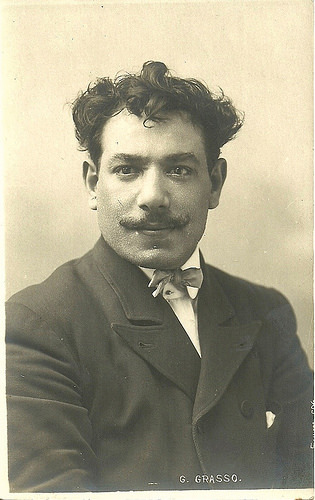
Italian postcard, no. 604. Photo: Sciutto.
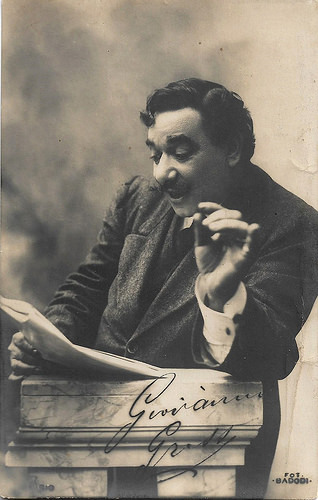
Italian postcard. Photo: Badodi, Milano, no. [510].
A physical obsession
At the end of 1906, the company departed for Spain, the initial stage of the long season of the big tours abroad, starting at the Novedades theater in Barcelona. They continued in Portugal, and from there went to South America. After reprisals in Buenos Aires, the famous French actor A. Lugné Poe, impresario of Eleonora Duse , hired the Sicilian actors for one of their most important international impact: a tour in France.
After their Parisian debut with Malia at the Marigny Theater, critics wrote: "No convention, no tradition: nature, life". The realism of the actors was compared to that of the 'Japanese', the recitation was defined as "of an infinitely accurate and precise accuracy". Grasso’s repertory was classic: 'A figghia di Joriu, Cavalleria rusticana and La morte civile by Paolo Giacometti, already known to the Parisian public. Great appreciation was also obtained for La lupa, La zolfara, and Rusidda, by critics such as C. Mendès and by actors like Mounet-Sully . The usual appreciation for the 'naturalness' of acting was now joined by the recognition for the great technical expertise of Grasso and his companions. Giovanni Verga withdrew his texts for the changes made arbitrarily by Grasso. This also happened afterwards with Capuana and even with Martoglio.
Preceded by the echo of his French success, Giovanni Grasso debuted in London, again with Malia. Here he saw the excellent criticisms repeated that praised his realism as "amazing, fulminant, colossal" and, again, his great acting technique. In October the company made its debut in Berlin.After a fleeting episode in Hungary, the company moved to Russia, at the time one of the most vital centres of the European theatre. The debut was in St. Petersburg, with Malia, Stone between stones by H. Sudermann, The zolfara, 'A figghia di Joriu and Feudalism. This was a Sicilian version by A. Campagna of Terra baixa (Lowlands), by Angel Guimerà and another pillar of the repertoire of Grasso after his South American tour. Subsequent shows were given in Moscow and Odessa, both very important for the construction of the 'fame' of Grasso and for the definition of his artistic figure.
In Moscow, personalities of the caliber of the innovating actor-director Konstantin Stanislavsk, author Vladimir Nemirovich-Danchenko and designer and director Edward Gordon Craig attended his shows, while Grasso, at the height of his success, was received at court. In Odessa he saw a fourteen-year-old Isaac Babel, who would later write on it in one of his Stories of Odessa (1931). In Babel's stunned words, Grasso’s performance of Grasso in Feudalism, already famous, exploded to theoretical attention, the famous anecdote for the way in which the pastor, played by Grasso, kills his rival by biting him in the throat, after having literally 'flown' across the whole scene.
In this respect, Vsevolod Meyerhold wrote: "I realised numerous laws of the biomechanics when I saw the acting of the magnificent Sicilian tragic actor Grasso". By identifying the biomechanical roots in the movement of the whole body, regardless of the part directly affected, Meyerhold was the first in succeeding to clarify that 'expressive power', which many had only intuitively perceived. With Grasso it was always the whole body that acted, spoke, or simply, was present, that is: to be perceived, on stage.
In 1909, after the Russian tour, the company returned to England. Particularly significant, this time, was Grasso’s interpretation of Othello, one of Grasso’s earliest roles but one he had always refused to represent outside his Catania. The success was, as usual, amazing, while critics spoke now openly of self-restraint, while for Feudalism they defined Grasso 'a physical obsession', but a controlled obsession and guided by technique.
In 1910, the company embarked on a second eight-month tour to South America, touching Argentina, Chile, Brazil and Peru. Back in Catania, after a new stop in England, Grasso married singer Concetta Silvia Carducci, with whom he had lived from the times of the Machiavelli variety, and with whom he had four children. He then dissolved the company for a long period of rest.
More or less since this time Grasso, now in a declining phase, threw off his theatrical activity, although never interrupted and even if the repertoire was enriched with new texts, including Il berretto a sonagli by Luigi Pirandello. In 1913 he played Cavalleria rusticana in Rome; in 1916 he was in Messina; in 1917 in Palermo and in 1919 in Rome, at the Teatro Eliseo.
In 1921, he left for a tour in the United States with Carolina Balistrieri Bragaglia as first actress. They debuted in New York with Feudalism, at the Major Royal Theatre, in the heart of the Italian quarter. The performances lasted for five months, with traditional battle horses like Malia and Cavalleria rusticana, but also with novelties by young authors.
Success continued to be great, but at the end of this tour Grasso's voice showed the first signs of hoarseness worsened over time. In 1923, he formed a new company with his brother Micio, his cousin Giovanni junior (who eventually would become a famous sound film actor too), and Virginia Balistrieri, junior’s wife. In 1927-1928 Grasso did his last tour in America. In his last years, with a by now almost extinct voice, he gradually lost the public’s favour.
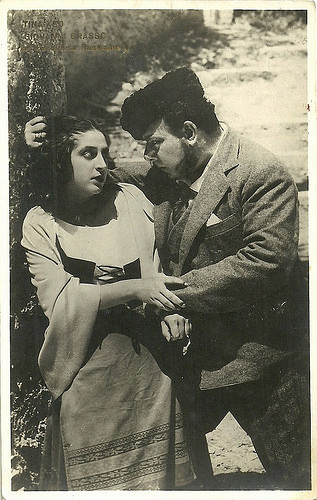
Italian postcard by G.B. Falci, Roma. Giovanni Grasso as Alfio and Tina Xeo as Santuzza and in the Italian silent film Cavalleria rusticana (Mario Gargiulo, 1924), based on Giovanni Verga's text.
The only surviving film
Giovanni Grasso was also a popular cinema actor. Already in 1910, during his second South American tour, he had shot two films based on his stage successes: La morte civile/Muerte civil (1910) and Cavalleria rusticana (1910). The two films were directed by Mario Gallo. But, as usual, Martoglio offered him the most significant occasions.
At the end of 1913, Martoglio had been appointed artistic director of the Rome based company Morgana films. Morgana produced the trilogy Capitan Blanco (Nino Martoglio, Roberto Danesi, 1914), starring Grasso and Virginia Balestrieri, Sperduti nel bui/Lost in the dark (Nino Martoglio, 1914), with Grasso, Balestrieri and Maria Carmi ; and Teresa Raquin (Nino Martoglio, 1914) with Maria Carmi and Dillo Lombardo but without Grasso. It was based on Émile Zola’s famous novel.
Sperduti nel bui/Lost in the dark is Grasso’s most famous film and was considered almost an incunabulum of neorealist cinema. Grasso interpreted the blind Nunzio. In a review, Bracco underlined the "expressive" contrast between the grace of the character and the power of the actor. In the early 1940s, Sperduti nel buio was hailed as precursor of what would become Italian Neorealism, but during the war the German took the print from the Roman archive. It never resurfaced; neither other prints of the film. This raised the film's mythology.
The cinematographic activity of Grasso continued until 1926. Between 1919 and 1926, he was very active and performed in some nine films, including Mala Pasqua (Ignazio Lupi, 1919) with Linda Pini , L'ospite sconosciuta/The Unknown Guest (Telemaco Ruggeri, 1923) with Pina Menichelli , and Cavalleria rusticana (Mario Gargiulo, 1924) with Grasso as Alfio, Mary Cléo Tarlarini as Nunzia, Tina Xeo as Santuzza and Livio Pavanelli as Turiddu.
Twice Grasso had the lead in Balzac adaptations Vautrin (Alexandre Davrennes, 1919) and Tromp-la-Mort (Devarennes, 1920). Amleto Palermi directed Grasso in three films: Dopo il peccato (1920) with Bella Starace Sainati, Il dramma dell’amore (1920) with Claretta Sabatelli , and La casa degli scapoli (1923) with Diomira Jacobini and Livio Pavanelli .
Grosso’s had his last film part in the Capuana adaptation Il cavalier Petagna (Mario Gargiulo, 1926), with Soava Gallone . Giovanni Grasso died in Catania in 1930. He was 56.
Unfortunately, almost all of Giovanni Grasso's films have been lost. With particular reference to Sperduti nel buio, one of the most sought films in the world of film archives and film history, we can only talk about it on the basis of the screenplay, photos and reviews. A booklet with 24 photos has been put online on the website Portale cinema muto italiano.
But sometimes fortune smiles at us. In 2005, at the Dutch EYE Filmmuseum, a tinted print of the short Cines film Un amore selvaggio (director unknown, 1912) was found, restored and relaunched internationally. Un amore selvaggio is a rural drama, clearly influenced by the literary works of Verga and Capuana. On a Sicilian farm, brother Giuseppe and sister Carmela work both. The rebel and violent Giuseppe is fired for offending his master, and would like to take his sister with him, but she refuses because she desperately loves the owner’s son Alessandro (Grasso).
Alessandro rejects her while he is already engaged. Carmela then tries to poison her rival in love, but she is discovered and in turn cast out. In order to take revenge, she tells Giuseppe that she has been seduced by Alessandro and asks her brother to kill him. But while she spies her rival's house she rolls into an embankment and is cared for by Alexander's good and kind girlfriend. Repentant, Carmela confesses Giuseppe she lied, just as he is about to hit Alessandro with a sickle. He forgives her and the two leave together.
But who were the Southern Italian actors in Un amore selvaggio? In 1912, Cines had shot three films with the famous southern actor Raffaele Viviani and his sister Luisella Viviani. These were known as their only film roles. Cines had also filmed two famous plays with Giovanni Grasso, Malia and Feudalismo. However, film historians Aldo Bernardini and Vittorio Martinelli did not connect him to Un amore selvaggio in their famous filmography Il cinema muto italiano).
In 2011, Un amore selvaggio was shown in Sicily before the heirs of Giovanni Grasso and Raffaele Viviani’s son. They immediately recognised the actors. Raffaele Viviani played Giovanni, his sister Luisella Viviani played Carmela and Grasso played Alessandro. This is remarkable while the brutal and tragic character of Giuseppe reminds of Grasso’s expressive parts, an here Viviani plays that part and Grasso has a more moderate role. Anyway, Un amore selvaggio (1912) is the only surviving film with Raffaele and Luisella Viviani, but also the only surviving film with Giovanni Grasso.
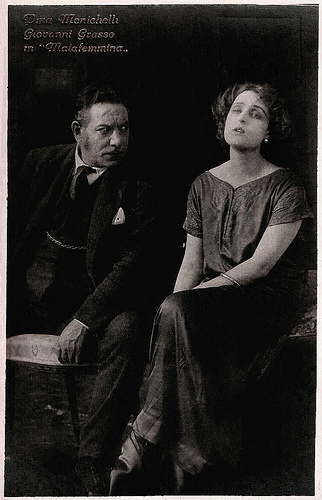
Italian postcard by G.B. Falci, Milano. Pina Menichelli and Giovanni Grasso in Malafemmina.
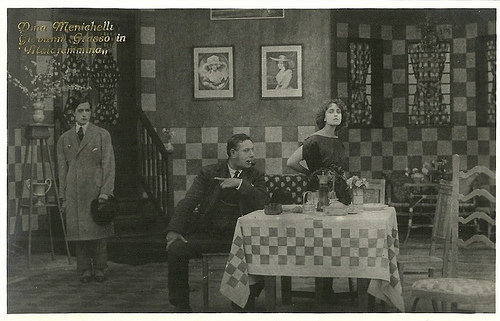
Italian postcard by G.B. Falci, Milano. Pina Menichelli and Giovanni Grasso in Malafemmina. Malafemmina is a film unknown to IMDb , but it was the alternative title of L'ospite sconosciuta/The Unknown Guest (Telemaco Ruggeri, 1923). The plot (written by future director Amleto Palermi) deals with Pietro, a young provincial (Andrea Conigliaro) who falls into the clutches of Stasia, a mundane adventuress (Menichelli) and spends his father's money on her. Di Scenta, the father (Grasso), pushes the woman to convince the son she never loved him and enforces this by having his son discovering the two of them in a restaurant. The son shoots the woman, while the father takes the blame.
The Italian censor didn't allow the representation nor even the suggestion that the son thinks he has to compete with his father in the love for Stasia. So all the scenes in which the father pretends his love for the woman in order to save his son were cut, as well as the intertitles explaining this situation. The film became incomprehensible and Italian critics didn't like it.
Sources: Franco Ruffini (Dizionario Biografico degli Italiani, Volume 58 2002 - Italian), Ipercultura (Italian), Wikipedia (Italian) and .

Italian postcard, no. 320. Photo: Photo Reale.

Italian postcard by Ed. Vettori, Bologna, no. 447.
Nature as a mirror
Giovanni Grasso was born in Catania, Sicily, in 1873, as the son of puppet master Angelo Grasso and his second wife Ciccia (Francesca) Tudisco, who was a puppet master too. From Naples, Angelo Grasso’s father supposedly introduced the puppet theatre in Catania. Angelo opened a small puppet theatre in Catania, Teatro Machiavelli.
After Angelo's death, his family turned it into a vaudeville theatre in order to survive. Small provincial companies stopped there, alternating edifying dramas with farces and subject performances ('scenoni'), inspired by news events. In this eclectic environment of the 1890s, young Giovanni Grasso was trained as a man of the theatre.
He decided to brush up his paternal puppets, presenting – successful - shows. Among his greatest admirers was the playwright and journalist Nino Martoglio, who led the famous actor Ernesto Rossi to the Machiavelli. At the end of the show, Rossi, dazed by the expressive power of the puppeteer, urged him to become an actor.
This was the first of more 'revelation meetings' – with people like Gabriele D'Annunzio, Russian playwright Isaac Babel, and Russian stage director Vsevolod Meyerhold - that punctuated Grasso’s life, whose art was perhaps greater and, above all, more meaningful than he was aware of. At Rossi's requests, Grasso rearranged the auditorium and increasingly alternated written texts with crime scenes, thus beginning to define his own dramaturgical repertory that clung to Sicilian texts but renewed by his interventions and his acting.
Among his battle horses were I mafiusi di La Vicaria di Palermo, by Gaspare Mosca & Giuseppe Rizzotto, La zolfara, by Giuseppe Giusti Sinopoli, and Cavalleria rusticana, by Giovanni Verga. I mafiusi (1863), was based on the stories of an authentic mafioso, a certain Gioacchino D'Angelo, just out of jail. The drama had an immediate and lasting success, especially when Grasso began to interpret it. Zolfara, based on the big upheaval of the strikes of the Sicilian miners, did not gain much recognition when premiered in 1895, but thanks to Grasso’s version in dialect, it became a triumph. Instead, Cavalleria rusticana, following Grasso’s often used practice, was represented in the Sicilian translation of Martoglio.
In 1901 Grasso formed his own company Città di Catania, with Angelo Musco as ‘brilliante’ and Carmelina Tria as first actress (later replaced by Mimì Aguglia and after her by Marinella Bragaglia). He did his first world tour, starting at the Politeama in Salerno (with La zolfara), on initiative of the capocomico (company manager) Mimì de Cesare, who sensed Grasso’s great talent. The tour subsequently touched Avellino and Naples, with a good artistic success but bad economic results.
The real consecration of Grasso, however, took place in Rome, where he was called for some charity performances organised for the victims of the Modica flood in 1902. Grasso made his debut in Argentina with Cavalleria rusticana and I mafiusi in 1901. When asked about Grasso, Martoglio answered: "His mirror is nature". This axiom, together with his powerful vigor, instinctive to the limit of violence, remained the trademark of the actor and his company. His assistant, the Argentine Luigi Capuana, offered him the reworking in dialect of his play Malia, while Grasso continued with resounding success his performances in Rome at the Teatro Metastasio.
In Catania, the Macchiavelli burned down in 1903. The same year Martoglio wrote for Grasso a new text, Nica, and together with him he raised the first Sicilian dialectal drama company, which included Musco, Bragaglia, Lo Turco, Totò Majorana, Micio Grasso, and the families Spadaro and Balistrieri. Their repertory included, in addition to the dramas already mentioned, La lupa and Caccia al lupo by Giovanni Verga, San Giuvanni addicullatu by Martoglio; and La festa di Adernò by Grasso himself.
After performances in Catania and Naples, the company set off for a new tour. While La zolfara played without great success in Milan, Gabriele D'Annunzio, present, was struck by the expressive power. Nica and Cavalleria rusticana fared better, even if critics condemned the interventions in the latter. After Milan, the tour continued touching Florence, Palermo, Messina and, again, Naples. Back in Catania in August 1903, Grasso had to accept another economic failure of the tour, and dedicated himself to the reconstruction of the Teatro Machiavelli.
Meanwhile, urged by V. Ferraù, administrator of the company, Martoglio gave life to the second Sicilian dialectal drama company. In 1904, this company set off for a new tour, ending in Turin. A novelty among the repertory became the hit of the season: 'A figghia di Joriu, Giuseppe Antonio Borgese’s Sicilian version of D'Annunzio's tragedy La figlia di Jorio (The Daughter of Iorio), performed at the Teatro Costanzi in Rome in 1904.

Italian postcard, no. 604. Photo: Sciutto.

Italian postcard. Photo: Badodi, Milano, no. [510].
A physical obsession
At the end of 1906, the company departed for Spain, the initial stage of the long season of the big tours abroad, starting at the Novedades theater in Barcelona. They continued in Portugal, and from there went to South America. After reprisals in Buenos Aires, the famous French actor A. Lugné Poe, impresario of Eleonora Duse , hired the Sicilian actors for one of their most important international impact: a tour in France.
After their Parisian debut with Malia at the Marigny Theater, critics wrote: "No convention, no tradition: nature, life". The realism of the actors was compared to that of the 'Japanese', the recitation was defined as "of an infinitely accurate and precise accuracy". Grasso’s repertory was classic: 'A figghia di Joriu, Cavalleria rusticana and La morte civile by Paolo Giacometti, already known to the Parisian public. Great appreciation was also obtained for La lupa, La zolfara, and Rusidda, by critics such as C. Mendès and by actors like Mounet-Sully . The usual appreciation for the 'naturalness' of acting was now joined by the recognition for the great technical expertise of Grasso and his companions. Giovanni Verga withdrew his texts for the changes made arbitrarily by Grasso. This also happened afterwards with Capuana and even with Martoglio.
Preceded by the echo of his French success, Giovanni Grasso debuted in London, again with Malia. Here he saw the excellent criticisms repeated that praised his realism as "amazing, fulminant, colossal" and, again, his great acting technique. In October the company made its debut in Berlin.After a fleeting episode in Hungary, the company moved to Russia, at the time one of the most vital centres of the European theatre. The debut was in St. Petersburg, with Malia, Stone between stones by H. Sudermann, The zolfara, 'A figghia di Joriu and Feudalism. This was a Sicilian version by A. Campagna of Terra baixa (Lowlands), by Angel Guimerà and another pillar of the repertoire of Grasso after his South American tour. Subsequent shows were given in Moscow and Odessa, both very important for the construction of the 'fame' of Grasso and for the definition of his artistic figure.
In Moscow, personalities of the caliber of the innovating actor-director Konstantin Stanislavsk, author Vladimir Nemirovich-Danchenko and designer and director Edward Gordon Craig attended his shows, while Grasso, at the height of his success, was received at court. In Odessa he saw a fourteen-year-old Isaac Babel, who would later write on it in one of his Stories of Odessa (1931). In Babel's stunned words, Grasso’s performance of Grasso in Feudalism, already famous, exploded to theoretical attention, the famous anecdote for the way in which the pastor, played by Grasso, kills his rival by biting him in the throat, after having literally 'flown' across the whole scene.
In this respect, Vsevolod Meyerhold wrote: "I realised numerous laws of the biomechanics when I saw the acting of the magnificent Sicilian tragic actor Grasso". By identifying the biomechanical roots in the movement of the whole body, regardless of the part directly affected, Meyerhold was the first in succeeding to clarify that 'expressive power', which many had only intuitively perceived. With Grasso it was always the whole body that acted, spoke, or simply, was present, that is: to be perceived, on stage.
In 1909, after the Russian tour, the company returned to England. Particularly significant, this time, was Grasso’s interpretation of Othello, one of Grasso’s earliest roles but one he had always refused to represent outside his Catania. The success was, as usual, amazing, while critics spoke now openly of self-restraint, while for Feudalism they defined Grasso 'a physical obsession', but a controlled obsession and guided by technique.
In 1910, the company embarked on a second eight-month tour to South America, touching Argentina, Chile, Brazil and Peru. Back in Catania, after a new stop in England, Grasso married singer Concetta Silvia Carducci, with whom he had lived from the times of the Machiavelli variety, and with whom he had four children. He then dissolved the company for a long period of rest.
More or less since this time Grasso, now in a declining phase, threw off his theatrical activity, although never interrupted and even if the repertoire was enriched with new texts, including Il berretto a sonagli by Luigi Pirandello. In 1913 he played Cavalleria rusticana in Rome; in 1916 he was in Messina; in 1917 in Palermo and in 1919 in Rome, at the Teatro Eliseo.
In 1921, he left for a tour in the United States with Carolina Balistrieri Bragaglia as first actress. They debuted in New York with Feudalism, at the Major Royal Theatre, in the heart of the Italian quarter. The performances lasted for five months, with traditional battle horses like Malia and Cavalleria rusticana, but also with novelties by young authors.
Success continued to be great, but at the end of this tour Grasso's voice showed the first signs of hoarseness worsened over time. In 1923, he formed a new company with his brother Micio, his cousin Giovanni junior (who eventually would become a famous sound film actor too), and Virginia Balistrieri, junior’s wife. In 1927-1928 Grasso did his last tour in America. In his last years, with a by now almost extinct voice, he gradually lost the public’s favour.

Italian postcard by G.B. Falci, Roma. Giovanni Grasso as Alfio and Tina Xeo as Santuzza and in the Italian silent film Cavalleria rusticana (Mario Gargiulo, 1924), based on Giovanni Verga's text.
The only surviving film
Giovanni Grasso was also a popular cinema actor. Already in 1910, during his second South American tour, he had shot two films based on his stage successes: La morte civile/Muerte civil (1910) and Cavalleria rusticana (1910). The two films were directed by Mario Gallo. But, as usual, Martoglio offered him the most significant occasions.
At the end of 1913, Martoglio had been appointed artistic director of the Rome based company Morgana films. Morgana produced the trilogy Capitan Blanco (Nino Martoglio, Roberto Danesi, 1914), starring Grasso and Virginia Balestrieri, Sperduti nel bui/Lost in the dark (Nino Martoglio, 1914), with Grasso, Balestrieri and Maria Carmi ; and Teresa Raquin (Nino Martoglio, 1914) with Maria Carmi and Dillo Lombardo but without Grasso. It was based on Émile Zola’s famous novel.
Sperduti nel bui/Lost in the dark is Grasso’s most famous film and was considered almost an incunabulum of neorealist cinema. Grasso interpreted the blind Nunzio. In a review, Bracco underlined the "expressive" contrast between the grace of the character and the power of the actor. In the early 1940s, Sperduti nel buio was hailed as precursor of what would become Italian Neorealism, but during the war the German took the print from the Roman archive. It never resurfaced; neither other prints of the film. This raised the film's mythology.
The cinematographic activity of Grasso continued until 1926. Between 1919 and 1926, he was very active and performed in some nine films, including Mala Pasqua (Ignazio Lupi, 1919) with Linda Pini , L'ospite sconosciuta/The Unknown Guest (Telemaco Ruggeri, 1923) with Pina Menichelli , and Cavalleria rusticana (Mario Gargiulo, 1924) with Grasso as Alfio, Mary Cléo Tarlarini as Nunzia, Tina Xeo as Santuzza and Livio Pavanelli as Turiddu.
Twice Grasso had the lead in Balzac adaptations Vautrin (Alexandre Davrennes, 1919) and Tromp-la-Mort (Devarennes, 1920). Amleto Palermi directed Grasso in three films: Dopo il peccato (1920) with Bella Starace Sainati, Il dramma dell’amore (1920) with Claretta Sabatelli , and La casa degli scapoli (1923) with Diomira Jacobini and Livio Pavanelli .
Grosso’s had his last film part in the Capuana adaptation Il cavalier Petagna (Mario Gargiulo, 1926), with Soava Gallone . Giovanni Grasso died in Catania in 1930. He was 56.
Unfortunately, almost all of Giovanni Grasso's films have been lost. With particular reference to Sperduti nel buio, one of the most sought films in the world of film archives and film history, we can only talk about it on the basis of the screenplay, photos and reviews. A booklet with 24 photos has been put online on the website Portale cinema muto italiano.
But sometimes fortune smiles at us. In 2005, at the Dutch EYE Filmmuseum, a tinted print of the short Cines film Un amore selvaggio (director unknown, 1912) was found, restored and relaunched internationally. Un amore selvaggio is a rural drama, clearly influenced by the literary works of Verga and Capuana. On a Sicilian farm, brother Giuseppe and sister Carmela work both. The rebel and violent Giuseppe is fired for offending his master, and would like to take his sister with him, but she refuses because she desperately loves the owner’s son Alessandro (Grasso).
Alessandro rejects her while he is already engaged. Carmela then tries to poison her rival in love, but she is discovered and in turn cast out. In order to take revenge, she tells Giuseppe that she has been seduced by Alessandro and asks her brother to kill him. But while she spies her rival's house she rolls into an embankment and is cared for by Alexander's good and kind girlfriend. Repentant, Carmela confesses Giuseppe she lied, just as he is about to hit Alessandro with a sickle. He forgives her and the two leave together.
But who were the Southern Italian actors in Un amore selvaggio? In 1912, Cines had shot three films with the famous southern actor Raffaele Viviani and his sister Luisella Viviani. These were known as their only film roles. Cines had also filmed two famous plays with Giovanni Grasso, Malia and Feudalismo. However, film historians Aldo Bernardini and Vittorio Martinelli did not connect him to Un amore selvaggio in their famous filmography Il cinema muto italiano).
In 2011, Un amore selvaggio was shown in Sicily before the heirs of Giovanni Grasso and Raffaele Viviani’s son. They immediately recognised the actors. Raffaele Viviani played Giovanni, his sister Luisella Viviani played Carmela and Grasso played Alessandro. This is remarkable while the brutal and tragic character of Giuseppe reminds of Grasso’s expressive parts, an here Viviani plays that part and Grasso has a more moderate role. Anyway, Un amore selvaggio (1912) is the only surviving film with Raffaele and Luisella Viviani, but also the only surviving film with Giovanni Grasso.

Italian postcard by G.B. Falci, Milano. Pina Menichelli and Giovanni Grasso in Malafemmina.

Italian postcard by G.B. Falci, Milano. Pina Menichelli and Giovanni Grasso in Malafemmina. Malafemmina is a film unknown to IMDb , but it was the alternative title of L'ospite sconosciuta/The Unknown Guest (Telemaco Ruggeri, 1923). The plot (written by future director Amleto Palermi) deals with Pietro, a young provincial (Andrea Conigliaro) who falls into the clutches of Stasia, a mundane adventuress (Menichelli) and spends his father's money on her. Di Scenta, the father (Grasso), pushes the woman to convince the son she never loved him and enforces this by having his son discovering the two of them in a restaurant. The son shoots the woman, while the father takes the blame.
The Italian censor didn't allow the representation nor even the suggestion that the son thinks he has to compete with his father in the love for Stasia. So all the scenes in which the father pretends his love for the woman in order to save his son were cut, as well as the intertitles explaining this situation. The film became incomprehensible and Italian critics didn't like it.
Sources: Franco Ruffini (Dizionario Biografico degli Italiani, Volume 58 2002 - Italian), Ipercultura (Italian), Wikipedia (Italian) and .
Published on September 11, 2018 22:00
September 10, 2018
Miou-Miou
French actress Miou-Miou (1950) is a 10-time César Award nominee and was one of the leading ladies of the French cinema during the 1970s, 1980s and 1990s. In her long career she has worked with such international directors as Michel Gondry, Bertrand Blier, Jacques Deray, Joseph Losey and Louis Malle. Her films include Les Valseuses/Going Places (1974), Coup de foudre/Entre Nous (1983), Milou en mai/May Fools (1990), Germinal (1993), and Le huitième jour/The Eighth Day (1996). She won the César Award for Best Actress for La dérobade/Memoirs of a French Whore (1979).
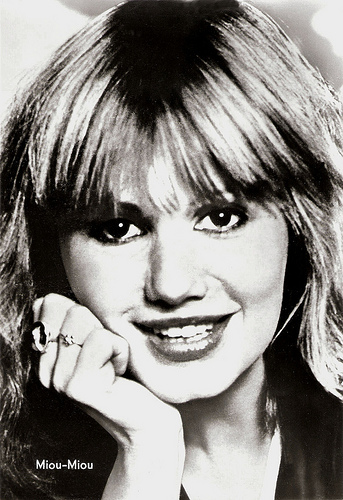
Big East-German card by VEB Progress Film-Verleih, Berlin, no. 9/82.

German promocard. Photo: publicity still for Un genio, due compari, un pollo/The Genius (Damiano Damiani, 1975) with Terence Hill and Robert Charlebois.
A cat’s meow
Miou-Miou was born Sylvette Herry in Paris in 1950. Her father was a gendarme, her mother a green-grocer.
While selling strawberries helping out at her mother's fruit and vegetable stand at the Les Halles street market, Sylvette was spotted by actor-director Romain Bouteille. He invited her to work at Cafe de la Gare, a little cafe-theatre in Montparnasse which would be the launching pad for numerous French actors including Gérard Depardieu , Patrick Dewaere and Coluche .
There she began as a cleaning lady, then became a dresser, then an actress. Her stage name, Miou-Miou (a reference to a cat’s meow), was given to her by Coluche , her companion at the very beginning of the Café de la Gare in 1969.
Later, she became romantically involved with Patrick Dewaere . She appeared with him in her film debut, La vie sentimentale de Georges Le Tueur/The Sentimental Life of George the Killer (Patrick Berger, 1971), also with Gérard Depardieu .
Miou-Miou soon appeared in several interesting films, including the cult film Themroc (Claude Faraldo, 1973) as the young neighbour of Michel Piccoli , Les granges brulées/The Burned Barns (Jean Chapot, 1973) with Simone Signoret and Alain Delon , and the successful comedy Les aventures de Rabbi Jacob/The Mad Adventures of Rabbi Jacob (Gérard Oury, 1973) as the daughter of Louis de Funès .
Her big break came with Bertrand Blier's Les Valseuses/Going Places (1974) opposite Gérard Depardieu and Patrick Dewaere . With its casual and rather raw approach, the film provoked controversy but was also a smash hit. Joan Dupont in The New York Times : “Les Valseuses sported a vast range of indecencies — nudity, obscene language, gestures and misogynous insults. It was a passionate adventure, flaunting bourgeois values and taking a poke at the new feminism. Depardieu and Dewaere were at their high-strung, sexy-brat best, with free spirited Miou-Miou as a girl careening in all directions, seeking elusive pleasure.”
After her role in Les valseuses, Miou-Miou began getting leading roles in comedy and drama. She co-starred again with Dewaere in F comme Fairbanks/F Like Fairbanks (Maurice Dugowson, 1976), but the filming was hard and hectic because she had just left Dewaere. The plot resembled the history of their relationship: the persistent and cheerful heroine is in love with a depression-prone neurasthenic, trying to awaken in him the hope and love of life.
Through the 1970s, she had roles in such art house films as the Swiss film Jonas qui aura 25 ans en l'an 2000/Jonah Who Will Be 25 in the Year 2000 (Alain Tanner, 1976), Dites-lui que je l'aime/This Sweet Sickness (Claude Miller, 1977) with Gérard Depardieu , and Les routes du sud /Roads to the South (Joseph Losey, 1978).
But she also appeared in several comedies such as Un genio, due compari, un pollo/A Genius, Two Friends, and an Idiot (Damiano Damiani, 1976). Sergio Leone directed the opening scene of this comic Spaghetti Western, which starred Terrence Hill as a genius conman. In Italy, she also made the drama Marcia trionfale/Victory March (Marco Bellocchio, 1976) with Franco Nero and Michele Placido, and the satirical comedy-drama L'ingorgo - Una storia impossibile/Traffic Jam (Luigi Comencini, 1979).
In the French drama La dérobade/Memoirs of a French Whore (Daniel Duval, 1979), Miou-Miou portrayed a young prostitute. She received her sole César Award for that role. The following year, she had a box office hit with the Policier La Femme flic/The Woman Cop (Yves Boisset, 1980) in which she portrayed a female police inspector, one of the first in the French cinema.

French postcard in the Signes du Zodiaque series by Editions F. Nugeron, no. 19. Caption: Poissons (Pisces).
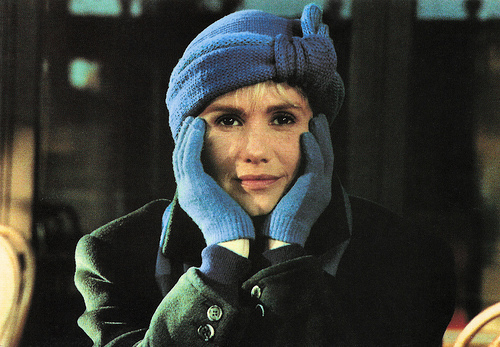
French postcard by Editions F. Nugeron. Photo: Collection d'Ecole de Cinéma Camiris, Lyon. Publicity still for La lectrice/The Reader (Michel Deville, 1988).
Reading sensual literature for a living
After her relationship with Patrick Dewaere , Miou-Miou became the partner of singer Julien Clerc. With both men, she had a daughter, writer Angele Herry-Leclerc (1974) with Dewaere, and actress-director Jeanne Herry (1978) with Clerc. Since 1998, she lives with the novelist Jean Teulé.
Through the 1980s Miou-Miou was seen in such films as La gueule du loup/The wolves (Michel Léviant, 1981), Coup de foudre/Entre nous (Diane Kurys, 1983) with Isabelle Huppert , and Blanche et Marie/Blanche and Marie (Jacques Renard, 1984) with Sandrine Bonnaire . She played opposite Lee Marvin in one of his last roles in Canicule/Dog Day (Yves Boisset, 1984).
Then she was nominated for the César for the provocative comedy-drama Tenue de soirée/Evening Dress (Bertrand Blier, 1986) in which she formed a threesome with Gérard Depardieu and Michel Blanc. Another international success was La lectrice/The Reader (Michel Deville, 1988). Miou-Miou played a woman who reads sensual literature to others for a living. The film won that year's Louis Delluc Prize, and was nominated for nine César Awards, including one for Best Actress.
The 1990s saw her first as the daughter of Michel Piccoli in Louis Malle's Milou en mai/May Fools (1990). The film portrays the impact of the French revolutionary fervour of May 1968 on a French village. She appeared opposite Gérard Depardieu in a new, epic production of Émile Zola's Germinal (Claude Berri, 1993).
Her other films at the time include in the thriller Netchaïev est de retour/Netchaïev is back (Jacques Deray, 1991), the comedy Un indien dans la ville/An Indian in the city (Hervé Palud, 1994), and the Belgian comedy-drama Le huitième jour/The Eighth Day (Jaco Van Dormael, 1996) with Daniel Auteuil. Miou-Miou received another César nomination for her role in the French-Spanish drama Nettoyage à sec/Dry Cleaning (Anne Fontaine, 1997).
By now in her fifties, her film roles had abated, as she also began to appear in theatre. Her later film roles include a woman who has lost her husband to a young blonde in L'après-midi de monsieur Andesmas (Michelle Porte, 2004), adapted from a Marguerite Duras novel, and an asylum inmate, set free during the 1939 Paris exodus before the Second World War in Folle Embellie (Dominique Cabréra, 2004). She also appeared with Gael García Bernal and Charlotte Gainsbourg in the surrealistic science fantasy comedy La Science des rêves/The Science of Sleep (2006) written and directed by Michel Gondry.
Among her more recent films are the Mystery Le Grand alibi/The Great Alibi (Pascal Bonitzer, 2008) based on a crime novel by Agatha Christie, and the thriller Arrêtez-moi/Stop Me (Jean-Paul Lilienfeld, 2013). In the latter, she played a woman who shows up at a police station and confesses to the murder of her abusive husband several years earlier. The female police officer ( Sophie Marceau ) who interviews her cannot understand why this woman who was never a suspect has come forward after all this time.
Miou-Miou continues to appear in films. Recently, she was directed by her daughter Jeanne Herry in La Pupille (2018). At IMDb , Steve Shelokhonov writes: “Miou-Miou has been an unusual personality in the French cinema. She once refused to take the Cesar Award for Best Actress, which she won for the title role in La dérobade (1979). She explained that refusal citing her belief that artists should not compete against each other. Her career was hardly affected by such a gesture.”
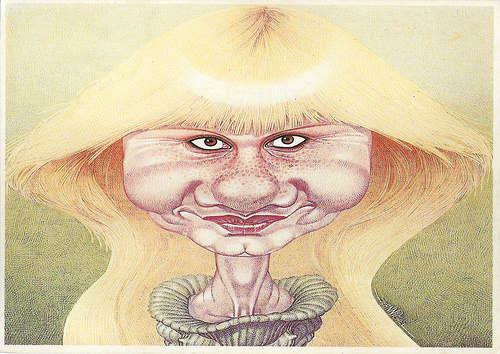
French postcard in the Les belles bobines series by Editions d'Art Yvonne, no. 24 00 0022. Illustration: Jean-Michel Renault.
Trailer Les Valseuses/Going Places (1974). Source: Michi Turner (YouTube).
Sources: Joan Dupont (The New York Times), (IMDb), Hal Erickson (AllMovie), Wikipedia and .

Big East-German card by VEB Progress Film-Verleih, Berlin, no. 9/82.

German promocard. Photo: publicity still for Un genio, due compari, un pollo/The Genius (Damiano Damiani, 1975) with Terence Hill and Robert Charlebois.
A cat’s meow
Miou-Miou was born Sylvette Herry in Paris in 1950. Her father was a gendarme, her mother a green-grocer.
While selling strawberries helping out at her mother's fruit and vegetable stand at the Les Halles street market, Sylvette was spotted by actor-director Romain Bouteille. He invited her to work at Cafe de la Gare, a little cafe-theatre in Montparnasse which would be the launching pad for numerous French actors including Gérard Depardieu , Patrick Dewaere and Coluche .
There she began as a cleaning lady, then became a dresser, then an actress. Her stage name, Miou-Miou (a reference to a cat’s meow), was given to her by Coluche , her companion at the very beginning of the Café de la Gare in 1969.
Later, she became romantically involved with Patrick Dewaere . She appeared with him in her film debut, La vie sentimentale de Georges Le Tueur/The Sentimental Life of George the Killer (Patrick Berger, 1971), also with Gérard Depardieu .
Miou-Miou soon appeared in several interesting films, including the cult film Themroc (Claude Faraldo, 1973) as the young neighbour of Michel Piccoli , Les granges brulées/The Burned Barns (Jean Chapot, 1973) with Simone Signoret and Alain Delon , and the successful comedy Les aventures de Rabbi Jacob/The Mad Adventures of Rabbi Jacob (Gérard Oury, 1973) as the daughter of Louis de Funès .
Her big break came with Bertrand Blier's Les Valseuses/Going Places (1974) opposite Gérard Depardieu and Patrick Dewaere . With its casual and rather raw approach, the film provoked controversy but was also a smash hit. Joan Dupont in The New York Times : “Les Valseuses sported a vast range of indecencies — nudity, obscene language, gestures and misogynous insults. It was a passionate adventure, flaunting bourgeois values and taking a poke at the new feminism. Depardieu and Dewaere were at their high-strung, sexy-brat best, with free spirited Miou-Miou as a girl careening in all directions, seeking elusive pleasure.”
After her role in Les valseuses, Miou-Miou began getting leading roles in comedy and drama. She co-starred again with Dewaere in F comme Fairbanks/F Like Fairbanks (Maurice Dugowson, 1976), but the filming was hard and hectic because she had just left Dewaere. The plot resembled the history of their relationship: the persistent and cheerful heroine is in love with a depression-prone neurasthenic, trying to awaken in him the hope and love of life.
Through the 1970s, she had roles in such art house films as the Swiss film Jonas qui aura 25 ans en l'an 2000/Jonah Who Will Be 25 in the Year 2000 (Alain Tanner, 1976), Dites-lui que je l'aime/This Sweet Sickness (Claude Miller, 1977) with Gérard Depardieu , and Les routes du sud /Roads to the South (Joseph Losey, 1978).
But she also appeared in several comedies such as Un genio, due compari, un pollo/A Genius, Two Friends, and an Idiot (Damiano Damiani, 1976). Sergio Leone directed the opening scene of this comic Spaghetti Western, which starred Terrence Hill as a genius conman. In Italy, she also made the drama Marcia trionfale/Victory March (Marco Bellocchio, 1976) with Franco Nero and Michele Placido, and the satirical comedy-drama L'ingorgo - Una storia impossibile/Traffic Jam (Luigi Comencini, 1979).
In the French drama La dérobade/Memoirs of a French Whore (Daniel Duval, 1979), Miou-Miou portrayed a young prostitute. She received her sole César Award for that role. The following year, she had a box office hit with the Policier La Femme flic/The Woman Cop (Yves Boisset, 1980) in which she portrayed a female police inspector, one of the first in the French cinema.

French postcard in the Signes du Zodiaque series by Editions F. Nugeron, no. 19. Caption: Poissons (Pisces).

French postcard by Editions F. Nugeron. Photo: Collection d'Ecole de Cinéma Camiris, Lyon. Publicity still for La lectrice/The Reader (Michel Deville, 1988).
Reading sensual literature for a living
After her relationship with Patrick Dewaere , Miou-Miou became the partner of singer Julien Clerc. With both men, she had a daughter, writer Angele Herry-Leclerc (1974) with Dewaere, and actress-director Jeanne Herry (1978) with Clerc. Since 1998, she lives with the novelist Jean Teulé.
Through the 1980s Miou-Miou was seen in such films as La gueule du loup/The wolves (Michel Léviant, 1981), Coup de foudre/Entre nous (Diane Kurys, 1983) with Isabelle Huppert , and Blanche et Marie/Blanche and Marie (Jacques Renard, 1984) with Sandrine Bonnaire . She played opposite Lee Marvin in one of his last roles in Canicule/Dog Day (Yves Boisset, 1984).
Then she was nominated for the César for the provocative comedy-drama Tenue de soirée/Evening Dress (Bertrand Blier, 1986) in which she formed a threesome with Gérard Depardieu and Michel Blanc. Another international success was La lectrice/The Reader (Michel Deville, 1988). Miou-Miou played a woman who reads sensual literature to others for a living. The film won that year's Louis Delluc Prize, and was nominated for nine César Awards, including one for Best Actress.
The 1990s saw her first as the daughter of Michel Piccoli in Louis Malle's Milou en mai/May Fools (1990). The film portrays the impact of the French revolutionary fervour of May 1968 on a French village. She appeared opposite Gérard Depardieu in a new, epic production of Émile Zola's Germinal (Claude Berri, 1993).
Her other films at the time include in the thriller Netchaïev est de retour/Netchaïev is back (Jacques Deray, 1991), the comedy Un indien dans la ville/An Indian in the city (Hervé Palud, 1994), and the Belgian comedy-drama Le huitième jour/The Eighth Day (Jaco Van Dormael, 1996) with Daniel Auteuil. Miou-Miou received another César nomination for her role in the French-Spanish drama Nettoyage à sec/Dry Cleaning (Anne Fontaine, 1997).
By now in her fifties, her film roles had abated, as she also began to appear in theatre. Her later film roles include a woman who has lost her husband to a young blonde in L'après-midi de monsieur Andesmas (Michelle Porte, 2004), adapted from a Marguerite Duras novel, and an asylum inmate, set free during the 1939 Paris exodus before the Second World War in Folle Embellie (Dominique Cabréra, 2004). She also appeared with Gael García Bernal and Charlotte Gainsbourg in the surrealistic science fantasy comedy La Science des rêves/The Science of Sleep (2006) written and directed by Michel Gondry.
Among her more recent films are the Mystery Le Grand alibi/The Great Alibi (Pascal Bonitzer, 2008) based on a crime novel by Agatha Christie, and the thriller Arrêtez-moi/Stop Me (Jean-Paul Lilienfeld, 2013). In the latter, she played a woman who shows up at a police station and confesses to the murder of her abusive husband several years earlier. The female police officer ( Sophie Marceau ) who interviews her cannot understand why this woman who was never a suspect has come forward after all this time.
Miou-Miou continues to appear in films. Recently, she was directed by her daughter Jeanne Herry in La Pupille (2018). At IMDb , Steve Shelokhonov writes: “Miou-Miou has been an unusual personality in the French cinema. She once refused to take the Cesar Award for Best Actress, which she won for the title role in La dérobade (1979). She explained that refusal citing her belief that artists should not compete against each other. Her career was hardly affected by such a gesture.”

French postcard in the Les belles bobines series by Editions d'Art Yvonne, no. 24 00 0022. Illustration: Jean-Michel Renault.
Trailer Les Valseuses/Going Places (1974). Source: Michi Turner (YouTube).
Sources: Joan Dupont (The New York Times), (IMDb), Hal Erickson (AllMovie), Wikipedia and .
Published on September 10, 2018 22:00
September 9, 2018
Ermete Zacconi
Ermete Zacconi (1857-1948) was a monstre sacré of the Italian theatre. He also acted in various Italian silent and sound films.
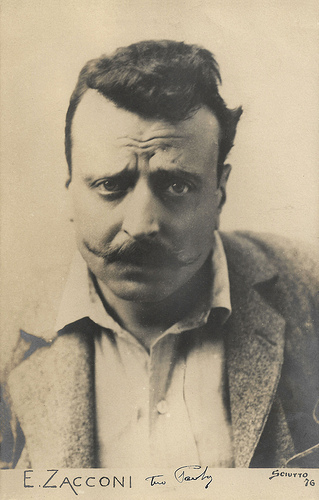
Italian postcard. Photo: Sciutto, no. 76.
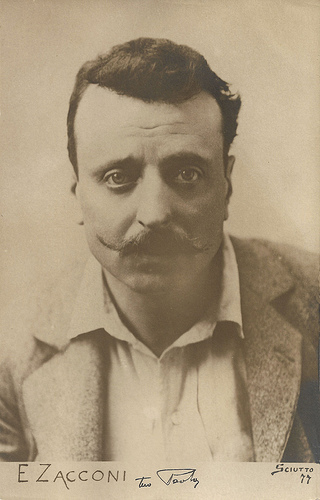
Italian postcard. Photo: Sciutto, no. 77.
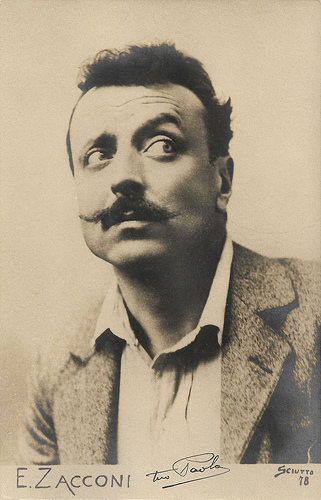
Italian postcard. Photo: Sciutto, no. 78.
Ghosts
Ermete Zacconi was born in Montecchio, Italy in 1857. He made his stage debut as a child, performing with his parents.
Over a period beginning in the 1880s, he held a leading position in troupes directed by G. Emmanuel, G. B. Marini, and V. Marini.
Zacconi developed as an actor during the period when naturalism was established in the Western European theatre. He became one of its most important representants. Following Emile Zola’s naturalism, this also included that he studied psychopathology, theories on the effects of heredity, and related subjects.
He did this in order to understand the psychology of man, in particular the clinical symptoms of an unhealthy psyche, which he reproduced with perfection. Zacconi’s most famous role was that of Oswald in Henrik Ibsen’s Spettri/Ghosts, reaching the maximum of realism with a shocking performance of the symptoms of the growing paralysis of the protagonist.
In Il cardinale Lambertini by Alfredo Testoni he did his most famous interpretation, showing a witty humour. His repertory also included the roles of Nikita in Lev Tolstoy’s The Power of Darkness, Kusovkin in Ivan Turgenev’s The Boarder, and Corrado in Paolo Giacometti’s La morte civile/Civil Death.
Zacconi also had lead roles in plays by Plato (Dialogues), William Shakespeare (King Lear, Othello), Carlo Goldoni, Alfred de Musset (Lorenzaccio), Alexandre Dumas fils, Ferenc Molnar, and August Strindberg.
After engagements with other companies, Zacconi organised his own troupe in 1894. He was worldwide appreciated, thanks to tours to France, Egypt, South-America and Russia.
At Eleonora Duse ’s invitation, he performed with her troupe in 1899, 1901, and 1921. Zacconi’s leading actresses were his wife Ines Cristina Zacconi and Paola Pezzaglia.

Italian postcard by Alterocca, Terni, no. 2379. Photo: G. Rossi. Card is dated February 1904.
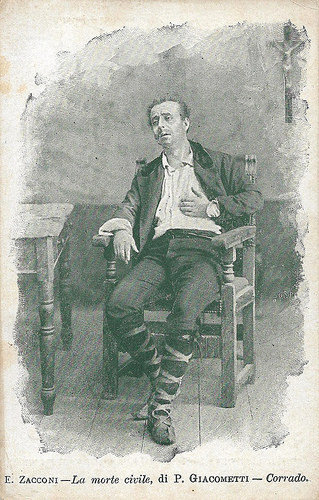
Italian postcard by Tip. Biondo, Palermo. Photo: Corrado. Ermete Zacconi in the stage play La morte civile by P. Giacometti.
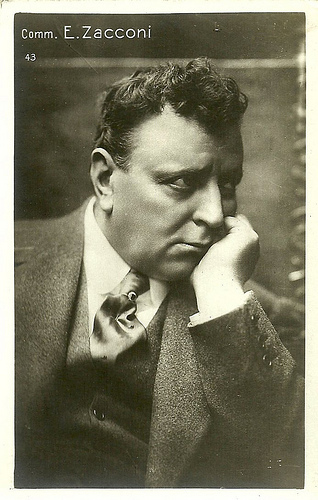
Italian postcard by Ed. Vettori, Bologna, no. 43.
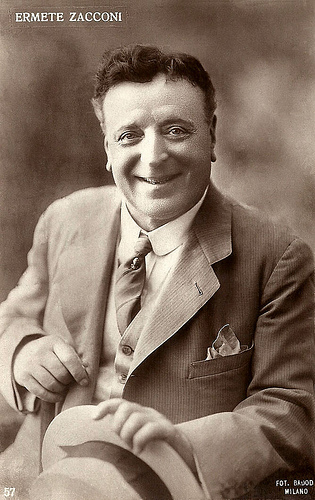
Italian postcard, no. 57. Photo Badodi, Milano.
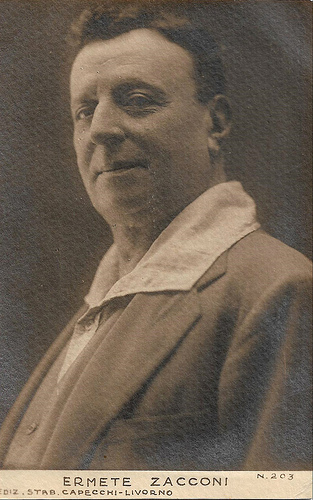
Italian postcard by Ed. Stab. Capecchi, Livorno, no. 203.
Padre
In 1912, Ermete Zacconi was won for the cinema. He made his film debut debuting with the spectacular melodrama Padre/Father (Dante Testa, Gino Zaccaria, 1912), based on a play by August Strindberg.
Padre narrates the story of an unjustly imprisoned businessman (Zacconi), who escapes and plots revenge on the culprit, his competitor. But he discovers the other has raised the convict’s daughter as his own, while the other man’s son is in love with the girl. The poor protagonist lets go, he even saves the culprit when a terrible blaze menaces to kill him. The other repents while dying, and indicates the girl her real father.
Padre was a success, inspiring other films with Zacconi such as Lo scomparso/The Dread of Doom (Dante Testa, 1913) and L'emigrante/The Emigrant ( Febo Mari , 1915), the latter on the emigration of Italians to the United States.
After two more films, Gli spettri/The Ghosts (A.G. Caldiera, 1918) and La forza della coscienza/The power of consciousness (Luigi Romano Borgnetto, 1918), Zacconi left the screen and focused on the stage.
In the late 1930s, he returned to the set for Coeur de gueux/Cuor di vagabondo/Heart of a Vagabond (Jean Epstein, 1936) with Madeleine Renaud , Un colpo di vento/A blast (C.V. Tavano, 1936), Pioggia d'estate/Summer rain (Michele Badich, 1937), Les perles de la couronne/The Pearls of the Crown (Sacha Guitry, 1937) with Jacqueline Delubac , and Processo e morte di Socrate/Trial and Death of Socrates (Corrado d'Errico, 1939) with Rossano Brazzi .
During the Second World War, Zacconi performed in Orizzonte dipinto/Horizon painting (Guido Salvini, 1941), Romanzo di un giovane povero/Romance of a poor young man (Guido Brignone, 1942), Le comte de Monte Cristo, 1ère époque: Edmond Dantès/The Count of Monte Cristo, 1st episode: Edmond Dantes (Robert Vernay, 1943) featuring Pierre Richard-Willm , and Piazza San Sepolcro/San Sepolcro Square (Giovacchino Forzano, 1943) starring Vivi Gioi .
Ermete Zacconi died in 1948 in Viareggio. His son Giuseppe Zacconi would later produce the film Le avventure di Pinocchio/The Adventures of Pinocchio (Gianetto Guardone, 1947).
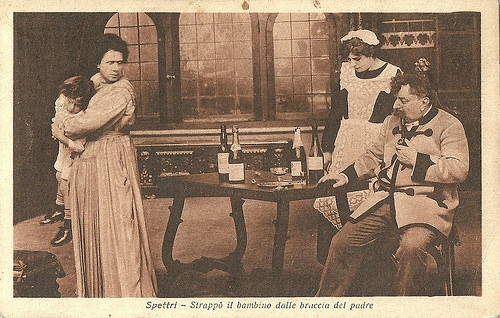
Italian postcard. Ermete Zacconi in the Italian silent film Spettri/Gli spettri (A.G. Caldiera, 1918), adapted from Henrik Ibsen's Ghosts (Gengangere, 1881). Caption: She grabbed the child from his father's arms. Helene Alving (Ines Cristina-Zacconi) and young Oswald (Peppino Zacconi), on the right captain Alving (Ermete Zacconi) and the maid, the mother of Regina.
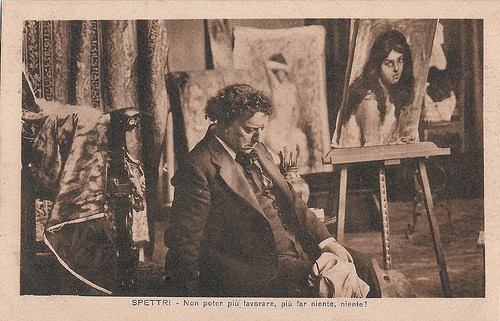
Italian postcard. Ermete Zacconi in the Italian silent film Spettri/Gli spettri (A.G. Caldiera, 1918), adapted from Henrik Ibsen's Ghosts (Gengangere, 1881). Caption: Not being able anymore to paint, to do anything, nothing!
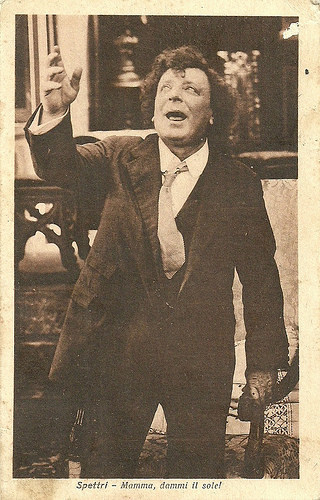
Italian postcard. Ermete Zacconi in Spettri/Gli spettri (A.G. Caldiera, 1918). Caption: Mama, give me the sun!
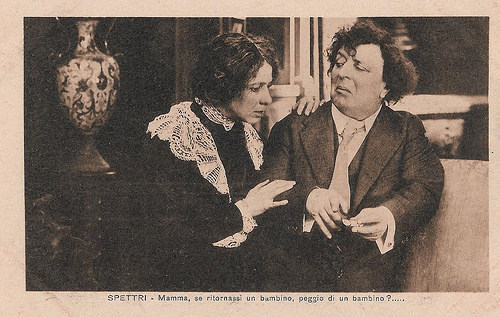
Italian postcard. Ermete Zacconi and Ines Cristina-Zacconi in Spettri/Gli spettri (A.G. Caldiera, 1918). Caption: Mama, what if I would become a child again, or even worse as a child?
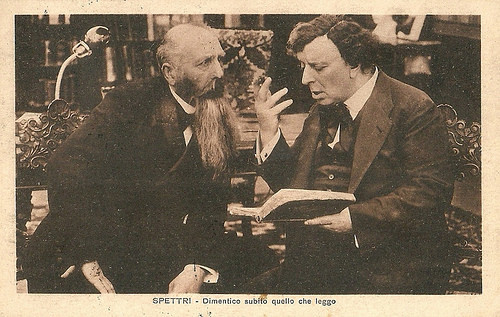
Italian postcard. Ermete Zacconi in Spettri/Gli spettri (A.G. Caldiera, 1918). Caption: I immediately forget what I have read. On the right Ermete Zacconi as Oswald/Osvaldo Halving. The man on the left could be Pastor Manders (Giovanni Grassi).
Sources: The free dictionary.com, Wikipedia (Italian and English), and .

Italian postcard. Photo: Sciutto, no. 76.

Italian postcard. Photo: Sciutto, no. 77.

Italian postcard. Photo: Sciutto, no. 78.
Ghosts
Ermete Zacconi was born in Montecchio, Italy in 1857. He made his stage debut as a child, performing with his parents.
Over a period beginning in the 1880s, he held a leading position in troupes directed by G. Emmanuel, G. B. Marini, and V. Marini.
Zacconi developed as an actor during the period when naturalism was established in the Western European theatre. He became one of its most important representants. Following Emile Zola’s naturalism, this also included that he studied psychopathology, theories on the effects of heredity, and related subjects.
He did this in order to understand the psychology of man, in particular the clinical symptoms of an unhealthy psyche, which he reproduced with perfection. Zacconi’s most famous role was that of Oswald in Henrik Ibsen’s Spettri/Ghosts, reaching the maximum of realism with a shocking performance of the symptoms of the growing paralysis of the protagonist.
In Il cardinale Lambertini by Alfredo Testoni he did his most famous interpretation, showing a witty humour. His repertory also included the roles of Nikita in Lev Tolstoy’s The Power of Darkness, Kusovkin in Ivan Turgenev’s The Boarder, and Corrado in Paolo Giacometti’s La morte civile/Civil Death.
Zacconi also had lead roles in plays by Plato (Dialogues), William Shakespeare (King Lear, Othello), Carlo Goldoni, Alfred de Musset (Lorenzaccio), Alexandre Dumas fils, Ferenc Molnar, and August Strindberg.
After engagements with other companies, Zacconi organised his own troupe in 1894. He was worldwide appreciated, thanks to tours to France, Egypt, South-America and Russia.
At Eleonora Duse ’s invitation, he performed with her troupe in 1899, 1901, and 1921. Zacconi’s leading actresses were his wife Ines Cristina Zacconi and Paola Pezzaglia.

Italian postcard by Alterocca, Terni, no. 2379. Photo: G. Rossi. Card is dated February 1904.

Italian postcard by Tip. Biondo, Palermo. Photo: Corrado. Ermete Zacconi in the stage play La morte civile by P. Giacometti.

Italian postcard by Ed. Vettori, Bologna, no. 43.

Italian postcard, no. 57. Photo Badodi, Milano.

Italian postcard by Ed. Stab. Capecchi, Livorno, no. 203.
Padre
In 1912, Ermete Zacconi was won for the cinema. He made his film debut debuting with the spectacular melodrama Padre/Father (Dante Testa, Gino Zaccaria, 1912), based on a play by August Strindberg.
Padre narrates the story of an unjustly imprisoned businessman (Zacconi), who escapes and plots revenge on the culprit, his competitor. But he discovers the other has raised the convict’s daughter as his own, while the other man’s son is in love with the girl. The poor protagonist lets go, he even saves the culprit when a terrible blaze menaces to kill him. The other repents while dying, and indicates the girl her real father.
Padre was a success, inspiring other films with Zacconi such as Lo scomparso/The Dread of Doom (Dante Testa, 1913) and L'emigrante/The Emigrant ( Febo Mari , 1915), the latter on the emigration of Italians to the United States.
After two more films, Gli spettri/The Ghosts (A.G. Caldiera, 1918) and La forza della coscienza/The power of consciousness (Luigi Romano Borgnetto, 1918), Zacconi left the screen and focused on the stage.
In the late 1930s, he returned to the set for Coeur de gueux/Cuor di vagabondo/Heart of a Vagabond (Jean Epstein, 1936) with Madeleine Renaud , Un colpo di vento/A blast (C.V. Tavano, 1936), Pioggia d'estate/Summer rain (Michele Badich, 1937), Les perles de la couronne/The Pearls of the Crown (Sacha Guitry, 1937) with Jacqueline Delubac , and Processo e morte di Socrate/Trial and Death of Socrates (Corrado d'Errico, 1939) with Rossano Brazzi .
During the Second World War, Zacconi performed in Orizzonte dipinto/Horizon painting (Guido Salvini, 1941), Romanzo di un giovane povero/Romance of a poor young man (Guido Brignone, 1942), Le comte de Monte Cristo, 1ère époque: Edmond Dantès/The Count of Monte Cristo, 1st episode: Edmond Dantes (Robert Vernay, 1943) featuring Pierre Richard-Willm , and Piazza San Sepolcro/San Sepolcro Square (Giovacchino Forzano, 1943) starring Vivi Gioi .
Ermete Zacconi died in 1948 in Viareggio. His son Giuseppe Zacconi would later produce the film Le avventure di Pinocchio/The Adventures of Pinocchio (Gianetto Guardone, 1947).

Italian postcard. Ermete Zacconi in the Italian silent film Spettri/Gli spettri (A.G. Caldiera, 1918), adapted from Henrik Ibsen's Ghosts (Gengangere, 1881). Caption: She grabbed the child from his father's arms. Helene Alving (Ines Cristina-Zacconi) and young Oswald (Peppino Zacconi), on the right captain Alving (Ermete Zacconi) and the maid, the mother of Regina.

Italian postcard. Ermete Zacconi in the Italian silent film Spettri/Gli spettri (A.G. Caldiera, 1918), adapted from Henrik Ibsen's Ghosts (Gengangere, 1881). Caption: Not being able anymore to paint, to do anything, nothing!

Italian postcard. Ermete Zacconi in Spettri/Gli spettri (A.G. Caldiera, 1918). Caption: Mama, give me the sun!

Italian postcard. Ermete Zacconi and Ines Cristina-Zacconi in Spettri/Gli spettri (A.G. Caldiera, 1918). Caption: Mama, what if I would become a child again, or even worse as a child?

Italian postcard. Ermete Zacconi in Spettri/Gli spettri (A.G. Caldiera, 1918). Caption: I immediately forget what I have read. On the right Ermete Zacconi as Oswald/Osvaldo Halving. The man on the left could be Pastor Manders (Giovanni Grassi).
Sources: The free dictionary.com, Wikipedia (Italian and English), and .
Published on September 09, 2018 22:00
September 8, 2018
Saint-Granier
Saint-Granier (1890-1976) was a French journalist, singer, (song)writer, actor, director, and radio star. Between the two wars he was one of the great personalities of the French cabaret. He was also the director of Paramount Pictures in France in the early 1930s.
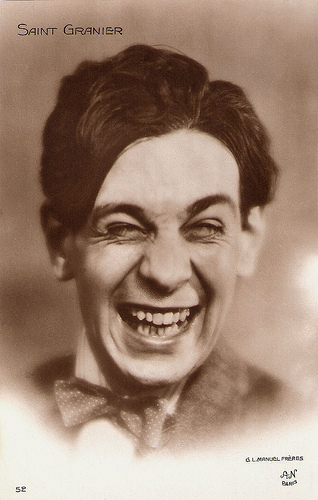
French postcard by A.N., Paris, no. 52. Photo: G.L. Manuel Frères.
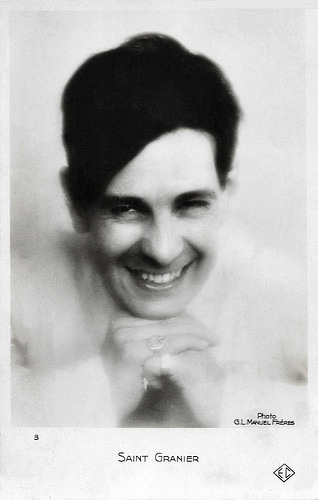
French postcard by Editions Chantal, Paris (EC), no. 3. Photo: G.L. Manuel Frères.
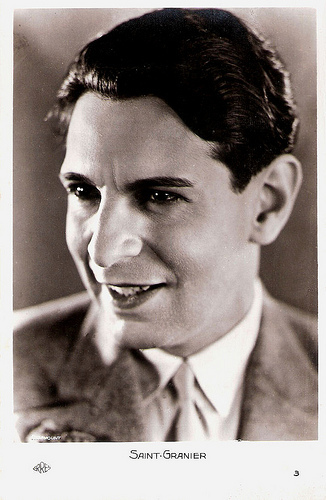
French postcard by Erres, no. 3. Photo: Paramount.
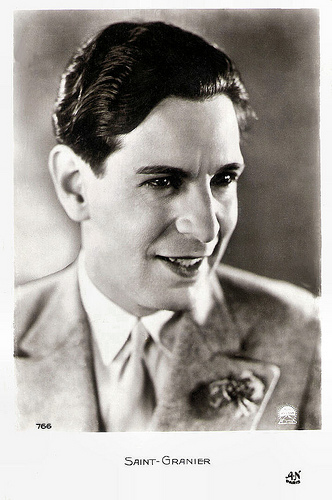
French postcard by A.N., Paris, no. 766. Photo: Paramount.
Hush you, it's crazy
Saint-Granier was born as Jean de Granier de Cassagnac in Paris in 1890. Among his aristocratic family were many journalists and MP’s.
He studied at the Lycee Condorcet in Paris, where he met Jean Cocteau and Alexandre Stavisky. He had to break up his studies in 1907, when his mother died. With the help of his family, he became a stockbroker from 1908 till 1912.
During this period he regularly attended the cabarets of Montmartre, where he heard Yvette Guilbert , Harry Fragson (his favourite) and Damia (who called herself Carmen at the time).
It stimulated him to become a satirist for such magazines as Le Charivari, l'Indiscret and Bravo, but he also wrote for such prominent newspapers as Le Matin and Le journal. He wrote newspaper columns about Parisian artistic life, and till the end of his life he considered himself a journalist.
In 1913 he embarked on the stage of the cabaret Le Porc Épic (the Porcupine) to sing his own texts. His status as a journalist led him to choose topics related to current events. In 1914 he wrote his first revue in collaboration with Yves Meralli, Tais toi, c'est fou ! (Hush you, it's crazy), which was presented at the venue Le Little Palace.
In 1916 he opened the cabaret Le Perchoir and in the 1918 the Theatre de la Potinière. Between 1921 and 1928 he moved to the Casino de Paris where he made his debut with Maurice Chevalier and where he created six revues: Dans un fauteuil (In a wheelchair) (1921), Paris en l'air (Paris in the air) (1922), En douce (The Sweet) (1923), On dit ça (They say it) (1924), Bonjour Paris (1926), and Tout Paris (1928).
Some of his songs became hits such as Billet doux (Love notes), C'est jeune et ça n'sait pas (It is young and does not know it) popularised by Maurice Chevalier , Yo t'aime yo t'adore (Yo love you yo adore), Marquita and finally Ramona. They were echoed by several famous performers till today and he would be associated with them throughout his life and against his will.
Parallel to these activities, he continued to sing and perform in cabarets such as Le Grillon (the Cricket), Le Moulin de la chanson (the Mill of the song), Le Caveau de la République (the Cave of the Republic), and then sang exclusively at La Pie qui chante (the singing Magpie).
He also performed in his own revue on which collaborated Willemetz Albert, Rip or Jacques Charles. His success earned him the derisive nickname ‘demi-mondain’ because of his origins and his upscale dating. Because of his seductive smile he was also called ‘singe Granier’ (monkey Granier).

French postcard by A.N., Paris, no. 698. Photo: Paramount.
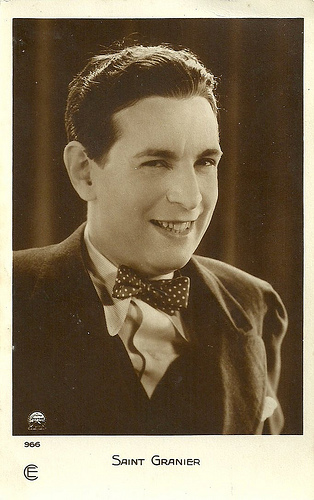
French postcard by Cinémagazine Edition, no. 966. Photo: Paramount.
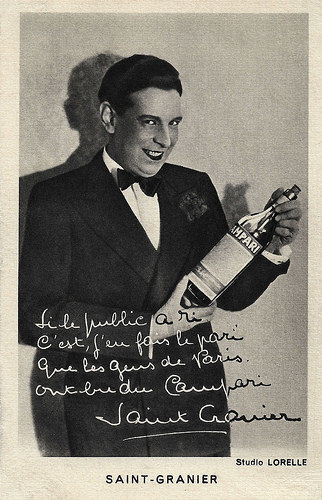
French postcard by Campari. Photo: Studio Lorelle. Caption: "Si le public a ri, C'est j'en fais le pari, que les gens de Paris, ont bu du Campari, Saint Granier." (If the audience laughed, I bet it, the people of Paris, drank Campari, Saint-Granier.")
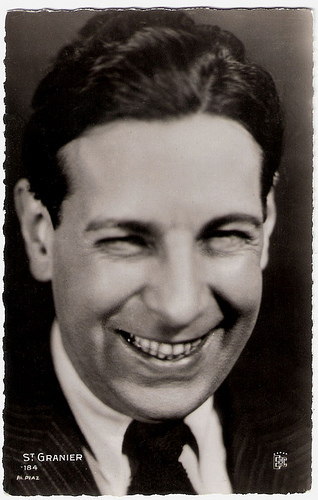
French postcard by EPC, Paris, no. 184. Photo: Piaz.
Paramount
In 1921, Saint-Grenier made his film debut in Villa Destin/Villa Fate (Marcel L'Herbier, 1921), an Oscar Wilde adaptation in which he co-starred with Alice Field .
Throughout the 1920s he continued to appear in such silent films as Le taxi 313-X-7 (Pierre Colombier, 1923), Par-dessus le mur (Pierre Colombier, 1923) with Dolly Davis , and La malchanceuse/The unlucky person (Donatien, Benito Perojo, 1925).
Then he sang Ramona in the French version of the Hollywood sound production Ramona (Edwin Carewe, 1928) starring Dolores del Rio . He also worked on Champagner/Champagne (Géza von Bolváry, 1929), the German version of Alfred Hitchcock’s Champagne (1930) with Betty Balfour starring in both versions.
Then Saint-Granier extended his activities for the cinema and became the director of Paramount Pictures for France from 1930 to 1932. During this period he also appeared in Paramount en parade/Paramount on Parade (Charles de Rochefort, 1930) with Maurice Chevalier , Chérie (Mona Goya, Louis Mercanton, 1930), and Maquillage/Make-up (Karl Anton, 1932) with Edwige Feuillère .
Then he went to the radio where he had made his debut in 1930. Seven years later he became the producer at Radio Cité, the most famous French radio station in the 1930s. There he produced with Jacques Canetti the first radio column, La minute du bon sens (The minute makes sense) later renamed by the public as La minute de Saint-Granier (The minute of Saint-Granier).
Incidentally he could be seen in the cinema, such as in the comedies Tartarin de Tarascon/Tartarin of Tarascon (Raymond Bernard, 1934) with Raimu , and Un coup de rouge/A glass of red wine (Gaston Roudès, 1937).
After the war he continued with his radio columns and made On chante dans mon quartier (The Songs of My Neighbourhood) (1945) with the legendary opening song by Francis Blanche, Ploum ploum Tralala.
He also continued to appear in films, such as in the musicals Destins/Fates (Richard Pottier, 1946) with Tino Rossi , Boîte de nuit/Hotbed of Sin (Alfred Rode, 1951) with Junie Astor , and as a presenter in the comedy Bébés à gogo/Babes a GoGo (Paul Mesnier, 1956) with Jane Sourza.
In the 1950s, he made the television show La joie de vivre (The joy of living). The success of the show lead to more jokes against him and he was nicknamed ‘the Marquis’ or ‘Saint-Ploum ploum’. In this period he decided to take a step back, and to continue only the radio column to keep in touch with the public.
Saint-Granier passed away in 1976 in Neuilly-sur-Seine, France, at the age of 88. He was the father of actor Jean Grenier.
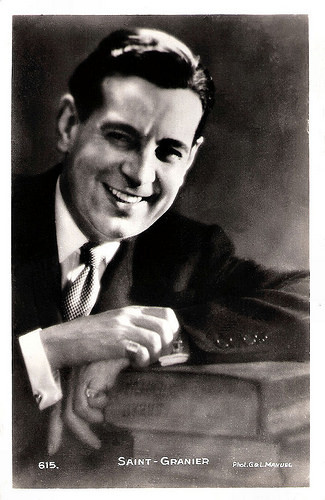
French postcard by Editions Chantal, Paris, no. 615. Photo: G & L Manuel.
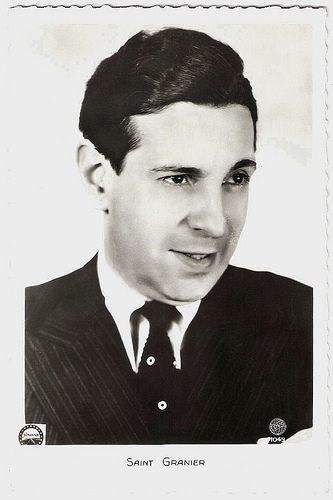
French postcard by EDUG, no. 1049. Photo: Paramount.
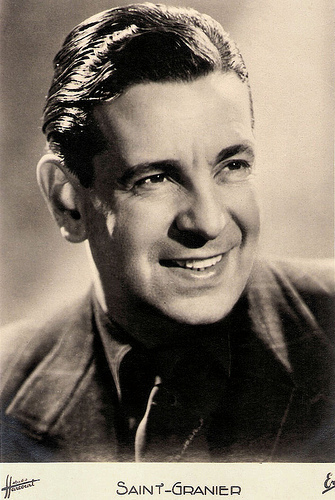
French postcard by Erpé. Photo: Studio Harcourt.
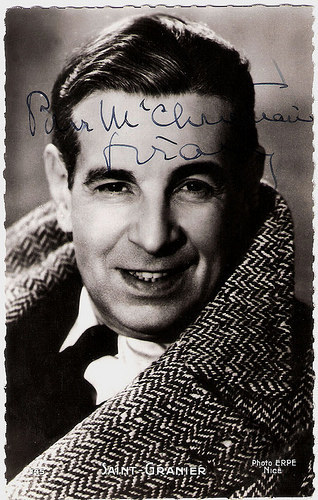
French postcard by Editions P.I., no. 145. Photo: ERPE, Nice.
Sources: Karine Le Bail (French - Radio France), Wikipedia (French), and .

French postcard by A.N., Paris, no. 52. Photo: G.L. Manuel Frères.

French postcard by Editions Chantal, Paris (EC), no. 3. Photo: G.L. Manuel Frères.

French postcard by Erres, no. 3. Photo: Paramount.

French postcard by A.N., Paris, no. 766. Photo: Paramount.
Hush you, it's crazy
Saint-Granier was born as Jean de Granier de Cassagnac in Paris in 1890. Among his aristocratic family were many journalists and MP’s.
He studied at the Lycee Condorcet in Paris, where he met Jean Cocteau and Alexandre Stavisky. He had to break up his studies in 1907, when his mother died. With the help of his family, he became a stockbroker from 1908 till 1912.
During this period he regularly attended the cabarets of Montmartre, where he heard Yvette Guilbert , Harry Fragson (his favourite) and Damia (who called herself Carmen at the time).
It stimulated him to become a satirist for such magazines as Le Charivari, l'Indiscret and Bravo, but he also wrote for such prominent newspapers as Le Matin and Le journal. He wrote newspaper columns about Parisian artistic life, and till the end of his life he considered himself a journalist.
In 1913 he embarked on the stage of the cabaret Le Porc Épic (the Porcupine) to sing his own texts. His status as a journalist led him to choose topics related to current events. In 1914 he wrote his first revue in collaboration with Yves Meralli, Tais toi, c'est fou ! (Hush you, it's crazy), which was presented at the venue Le Little Palace.
In 1916 he opened the cabaret Le Perchoir and in the 1918 the Theatre de la Potinière. Between 1921 and 1928 he moved to the Casino de Paris where he made his debut with Maurice Chevalier and where he created six revues: Dans un fauteuil (In a wheelchair) (1921), Paris en l'air (Paris in the air) (1922), En douce (The Sweet) (1923), On dit ça (They say it) (1924), Bonjour Paris (1926), and Tout Paris (1928).
Some of his songs became hits such as Billet doux (Love notes), C'est jeune et ça n'sait pas (It is young and does not know it) popularised by Maurice Chevalier , Yo t'aime yo t'adore (Yo love you yo adore), Marquita and finally Ramona. They were echoed by several famous performers till today and he would be associated with them throughout his life and against his will.
Parallel to these activities, he continued to sing and perform in cabarets such as Le Grillon (the Cricket), Le Moulin de la chanson (the Mill of the song), Le Caveau de la République (the Cave of the Republic), and then sang exclusively at La Pie qui chante (the singing Magpie).
He also performed in his own revue on which collaborated Willemetz Albert, Rip or Jacques Charles. His success earned him the derisive nickname ‘demi-mondain’ because of his origins and his upscale dating. Because of his seductive smile he was also called ‘singe Granier’ (monkey Granier).

French postcard by A.N., Paris, no. 698. Photo: Paramount.

French postcard by Cinémagazine Edition, no. 966. Photo: Paramount.

French postcard by Campari. Photo: Studio Lorelle. Caption: "Si le public a ri, C'est j'en fais le pari, que les gens de Paris, ont bu du Campari, Saint Granier." (If the audience laughed, I bet it, the people of Paris, drank Campari, Saint-Granier.")

French postcard by EPC, Paris, no. 184. Photo: Piaz.
Paramount
In 1921, Saint-Grenier made his film debut in Villa Destin/Villa Fate (Marcel L'Herbier, 1921), an Oscar Wilde adaptation in which he co-starred with Alice Field .
Throughout the 1920s he continued to appear in such silent films as Le taxi 313-X-7 (Pierre Colombier, 1923), Par-dessus le mur (Pierre Colombier, 1923) with Dolly Davis , and La malchanceuse/The unlucky person (Donatien, Benito Perojo, 1925).
Then he sang Ramona in the French version of the Hollywood sound production Ramona (Edwin Carewe, 1928) starring Dolores del Rio . He also worked on Champagner/Champagne (Géza von Bolváry, 1929), the German version of Alfred Hitchcock’s Champagne (1930) with Betty Balfour starring in both versions.
Then Saint-Granier extended his activities for the cinema and became the director of Paramount Pictures for France from 1930 to 1932. During this period he also appeared in Paramount en parade/Paramount on Parade (Charles de Rochefort, 1930) with Maurice Chevalier , Chérie (Mona Goya, Louis Mercanton, 1930), and Maquillage/Make-up (Karl Anton, 1932) with Edwige Feuillère .
Then he went to the radio where he had made his debut in 1930. Seven years later he became the producer at Radio Cité, the most famous French radio station in the 1930s. There he produced with Jacques Canetti the first radio column, La minute du bon sens (The minute makes sense) later renamed by the public as La minute de Saint-Granier (The minute of Saint-Granier).
Incidentally he could be seen in the cinema, such as in the comedies Tartarin de Tarascon/Tartarin of Tarascon (Raymond Bernard, 1934) with Raimu , and Un coup de rouge/A glass of red wine (Gaston Roudès, 1937).
After the war he continued with his radio columns and made On chante dans mon quartier (The Songs of My Neighbourhood) (1945) with the legendary opening song by Francis Blanche, Ploum ploum Tralala.
He also continued to appear in films, such as in the musicals Destins/Fates (Richard Pottier, 1946) with Tino Rossi , Boîte de nuit/Hotbed of Sin (Alfred Rode, 1951) with Junie Astor , and as a presenter in the comedy Bébés à gogo/Babes a GoGo (Paul Mesnier, 1956) with Jane Sourza.
In the 1950s, he made the television show La joie de vivre (The joy of living). The success of the show lead to more jokes against him and he was nicknamed ‘the Marquis’ or ‘Saint-Ploum ploum’. In this period he decided to take a step back, and to continue only the radio column to keep in touch with the public.
Saint-Granier passed away in 1976 in Neuilly-sur-Seine, France, at the age of 88. He was the father of actor Jean Grenier.

French postcard by Editions Chantal, Paris, no. 615. Photo: G & L Manuel.

French postcard by EDUG, no. 1049. Photo: Paramount.

French postcard by Erpé. Photo: Studio Harcourt.

French postcard by Editions P.I., no. 145. Photo: ERPE, Nice.
Sources: Karine Le Bail (French - Radio France), Wikipedia (French), and .
Published on September 08, 2018 22:00
Paul van Yperen's Blog
- Paul van Yperen's profile
- 13 followers
Paul van Yperen isn't a Goodreads Author
(yet),
but they
do have a blog,
so here are some recent posts imported from
their feed.



